250 Artworks
1/118
Earn XP
Name | Mastery | Learn | Test | Matching | Spaced |
|---|
No study sessions yet.
119 Terms

Apollo 11 Stones. Namibia. c. 25,500–25,300 B.C.E. Charcoal on stone.
Global Prehistory - Africa
Animal-like feature in profile view
Art is portable → didn’t have established homes
Human’s desire to create “art” or make a mark
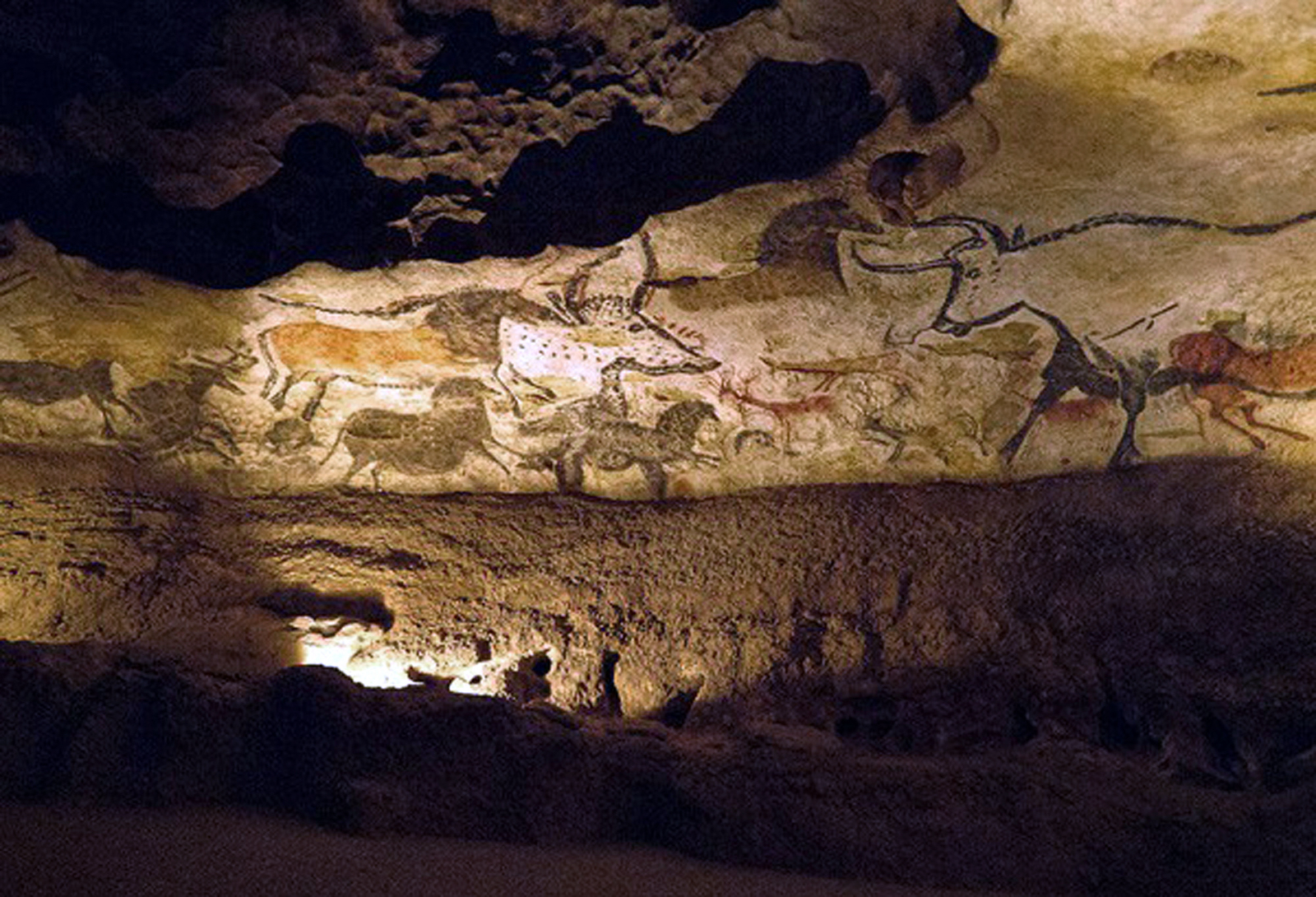
Great Hall of the Bulls. Lascaux, France. Paleolithic Europe. 15,000–13,000 B.C.E. Rock painting.
Global Prehistory - Western Europe
Twisted perspective (heads profile, horns from front)
One of the earliest appearances of males in art
Illusion of motion
Scale → bulls are so large
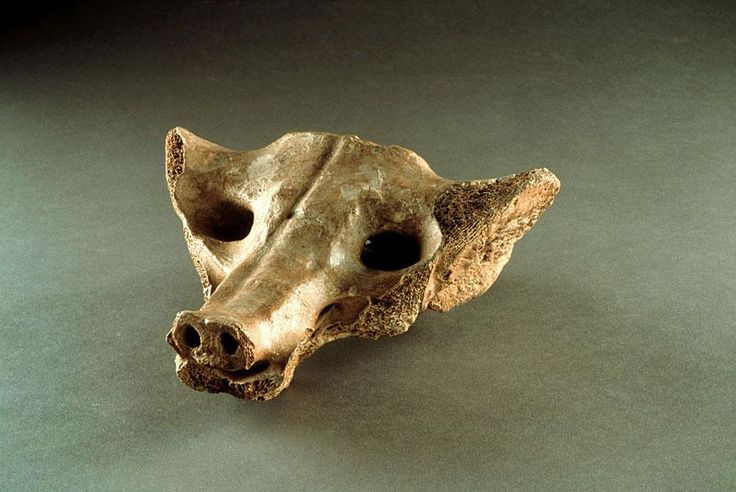
Camelid Sacrum. Tequixquiac, central Mexico. 14,000– 7000 B.C.E. Bone.
Global Prehistory - Mexico
Possibly looks like a dog
One of the earliest cultural artifacts found in Mesoamerica
Sacrum: pelvis bone
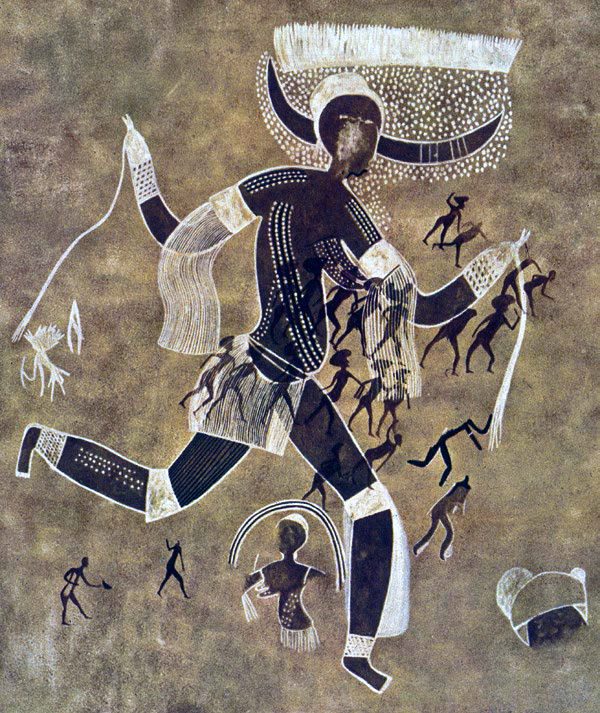
Running Horned Woman. Tassili n’Ajjer, Algeria. 6000–4000 B.C.E. Pigment on rock.
Global Prehistory - Africa
Large woman surrounded by smaller people
Featureless face
Feels very celebratory
Naturalistic and stylized
Lots of movement, contrast, linework, shapes, scale

Beaker with Ibex Motifs. Susa, Iran. 4200–3500 B.C.E. Painted terra cotta.
Global Prehistory - Iran
Ram → profile view with horns wrapping around (stylized sense of horn)
Incredible precision
Funerary vase/secondary burial objects (given to deceased)
Synthesis of the environment of the first agricultural communities of ancient Mesopotamia

Anthropomorphic Stele. Arabian Peninsula. Fourth millennium B.C.E. Sandstone.
Global Prehistory - Middle East
Earliest depiction of facial features
Probably to recognize a warrior
Stele: grave marker
Free-standing stone sculpture
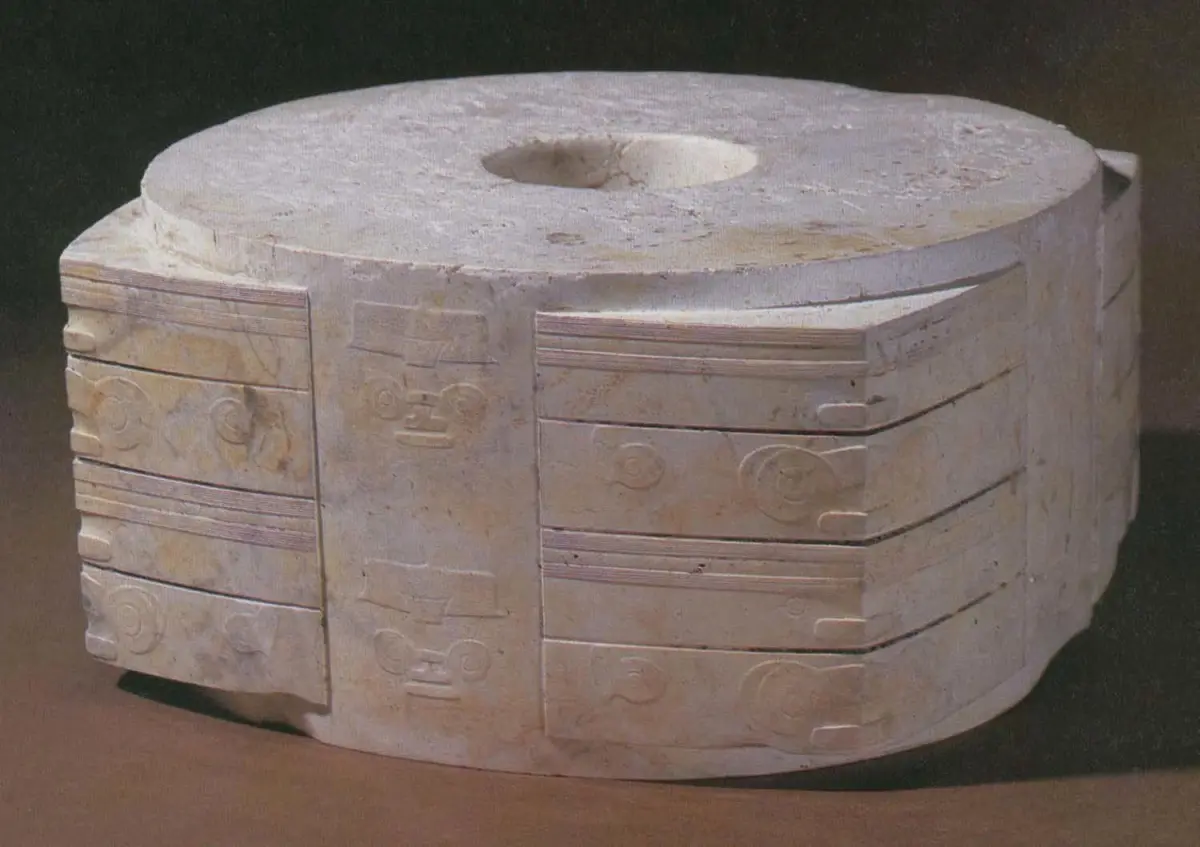
Jade Cong. Liangzhu, China. 3300–2200 B.C.E. Carved jade.
Global Prehistory - China
Circles most likely represent souls
Neolithic period - age before the use of metal
Grand burial objects (found in the graves of leaders)
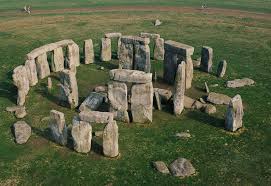
Stonehenge. Wiltshire, UK. Neolithic Europe. c. 2500–1600 B.C.E. Sandstone.
Global Prehistory - England
Stonehenge = “hanging stones”
Earliest form of architecture
Post + Lintel construction (first of its kind)
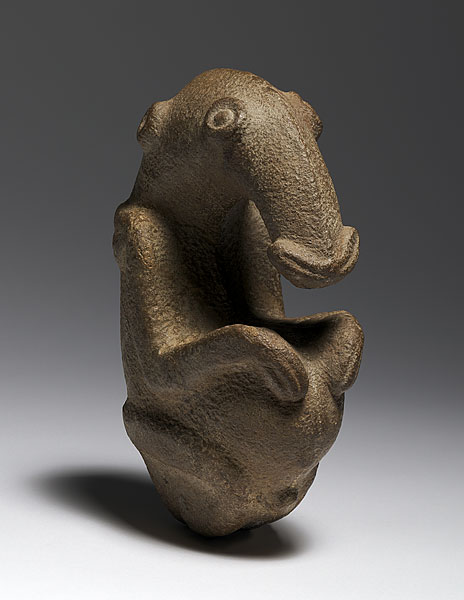
The Ambum Stone. Papua New Guinea. c. 1500 B.C.E. Greywacke.
Global Prehistory - Pacific Islands
Anteater holding its stomach
First real attempt at a sculpture of an animal
One of the earliest known Pacific artworks
Zoomorphic figure

Tlatilco Female Figurine. Central Mexico, site of Tlatilco. 1200–900 B.C.E. Ceramic.
Global Prehistoric - Mexico
Very elaborate hairstyle → Huge jump in sophistication
Much more detailed
Tlatilco figures: small ceramic figures, often women, found in Central Mexico
Compare with Venus of Villandof?
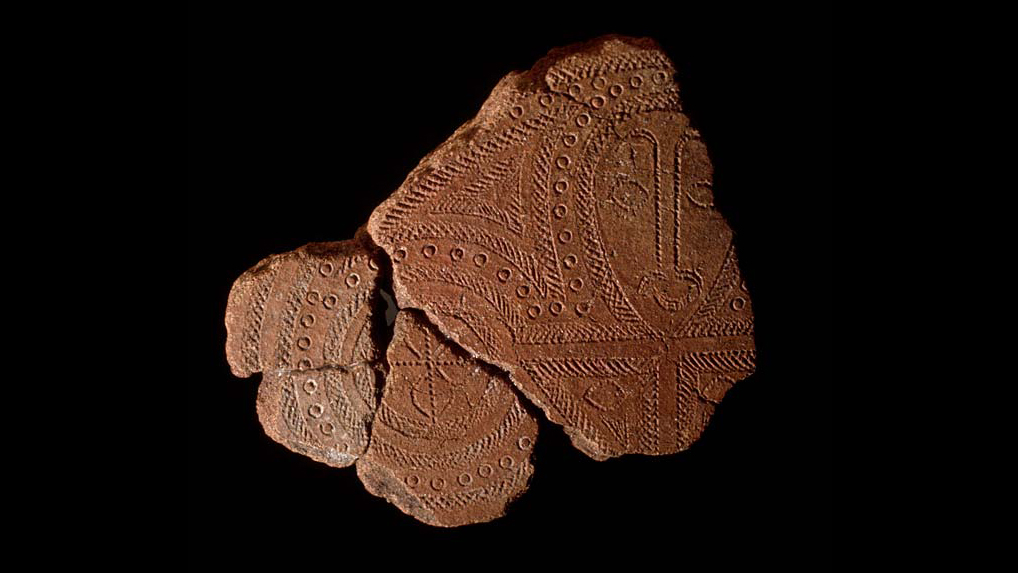
Terra cotta fragment. Lapita. Solomon Islands, Reef Islands. 1000 B.C.E. Terra cotta (incised).
Global Prehistory - Pacific Islands
Regarded for detail and precision
Earliest form of stamps
Lapita Pottery - ancient Pacific culture
World of pottery is advancing

Nan Madol. Pohnpei, Micronesia. Saudeleur Dynasty. c. 700–1600 C.E. Basalt boulders and prismatic columns.
Pacific - Micronesia
Prismatic columns
Stacked stones
Capitol for important people and king
Meeting place for tribe, commercial center/educational center
Not lasting because not organized well on top of each other
Themes: Royalty, Religion, Socio-economic Status
Connections: Stonehenge, Acropolis, other general temples
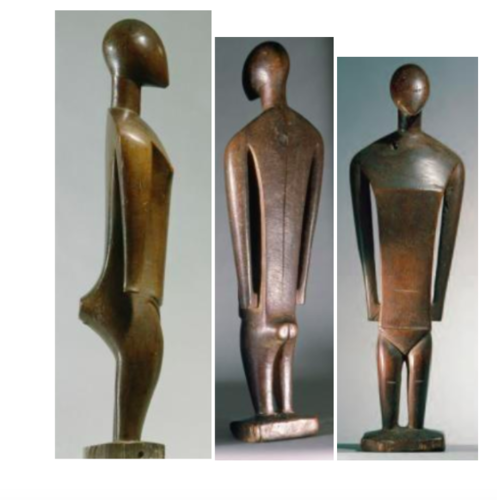
Female Deity. Nukuoro, Micronesia. c. 18th to 19th century C.E. Wood.
Pacific - Micronesia
Reliquary figure
Considered the resting place of god or dietied ancestral spirit during harvest festival
Used to have feathers and paint
Themes: Religion, God, Female Form
Connections: Venus of Villandof, Female Tlacticlo Figurines, Peplos Korous, anthropomorphic stele
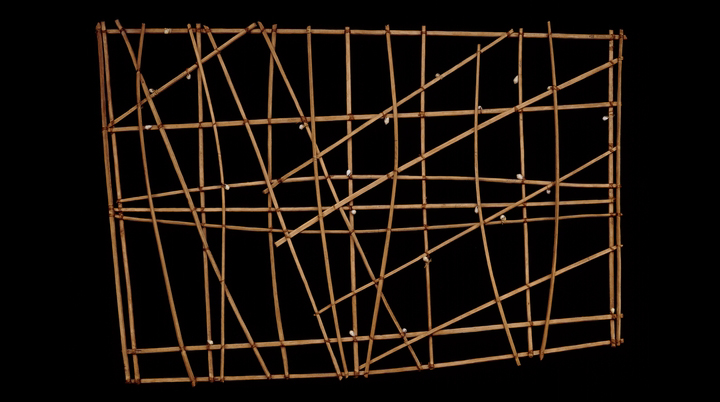
Navigation Chart. Marshall Islands, Micronesia. 19th to early 20th century C.E. Wood and ber.
Pacific - Marshall Islands
Was not brought onto sea because too fragile
Personalized - person who made it was only one who could decipher it
Sticks indicate wave swells and patterns, shells indicate islands
Shows sophistication of navigators knowledge and learning techniques (early cartography techniques)
Themes: Navigation, Water, Ocean

‘Ahu ‘ula (feather cape). Hawaiian. Late 18th century C.E. Feathers and ber.
Pacific - Hawaii
Fitted cloak with bright colors
Ceremonial sign of power and bravery
Hawaiian culture → yellow feathers were valuable because of their scarcity
Worn by higher up during ceremonies and battle
Made from super rare bird
Themes: Power, Bravery
Connections: Nan Madol
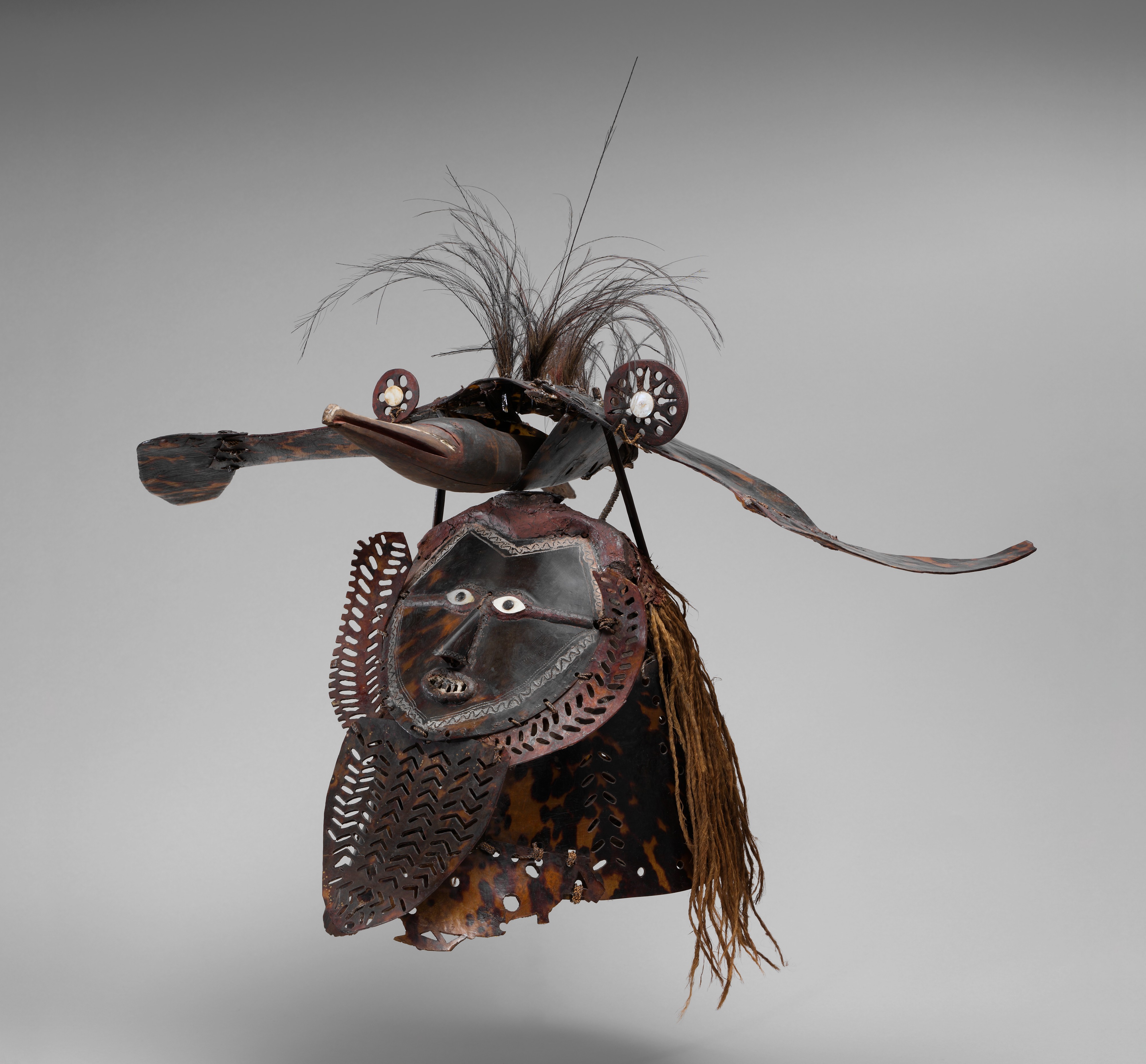
Buk Mask. Torres Strait. Mid- to late 19th century C.E. Turtle shell, wood, ber, feathers, and shell.
Pacific - Torres Strait
3 sections → human face, bird, feathers
For male initiation and funerary rituals
Natural materials
Big focus on movement and flight
Themes: Familial connection, transformation, coming of age, nature and man, afterlife
Connections: African masks
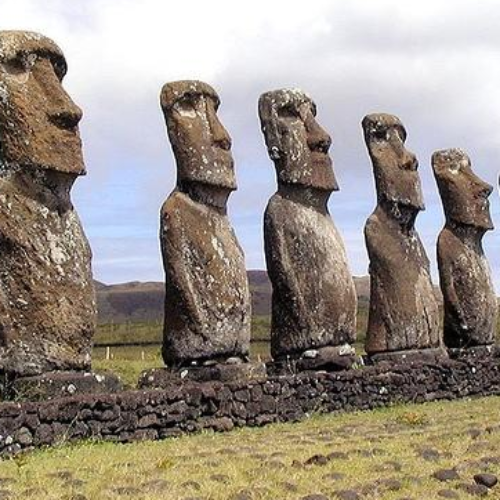
Moai on platform (ahu). Rapa Nui (Easter Island). c. 1100–1600 C.E. Volcanic tuff figures on basalt base.
Pacific - Easter Island
Made over a long period of time
Eventually started topping over, but over time, they got bigger and more detailed (shows that the people making them were advancing)
Made to protect the island/guardians of the island
Faced towards ocean (not sea) to protect island
Used to have coral eyes, but British took them off, and in the culture, taking the eyes out means they “die”
Themes: Spiritual, protection
Connections: Vitive Figures, Female Diety, Lamassu
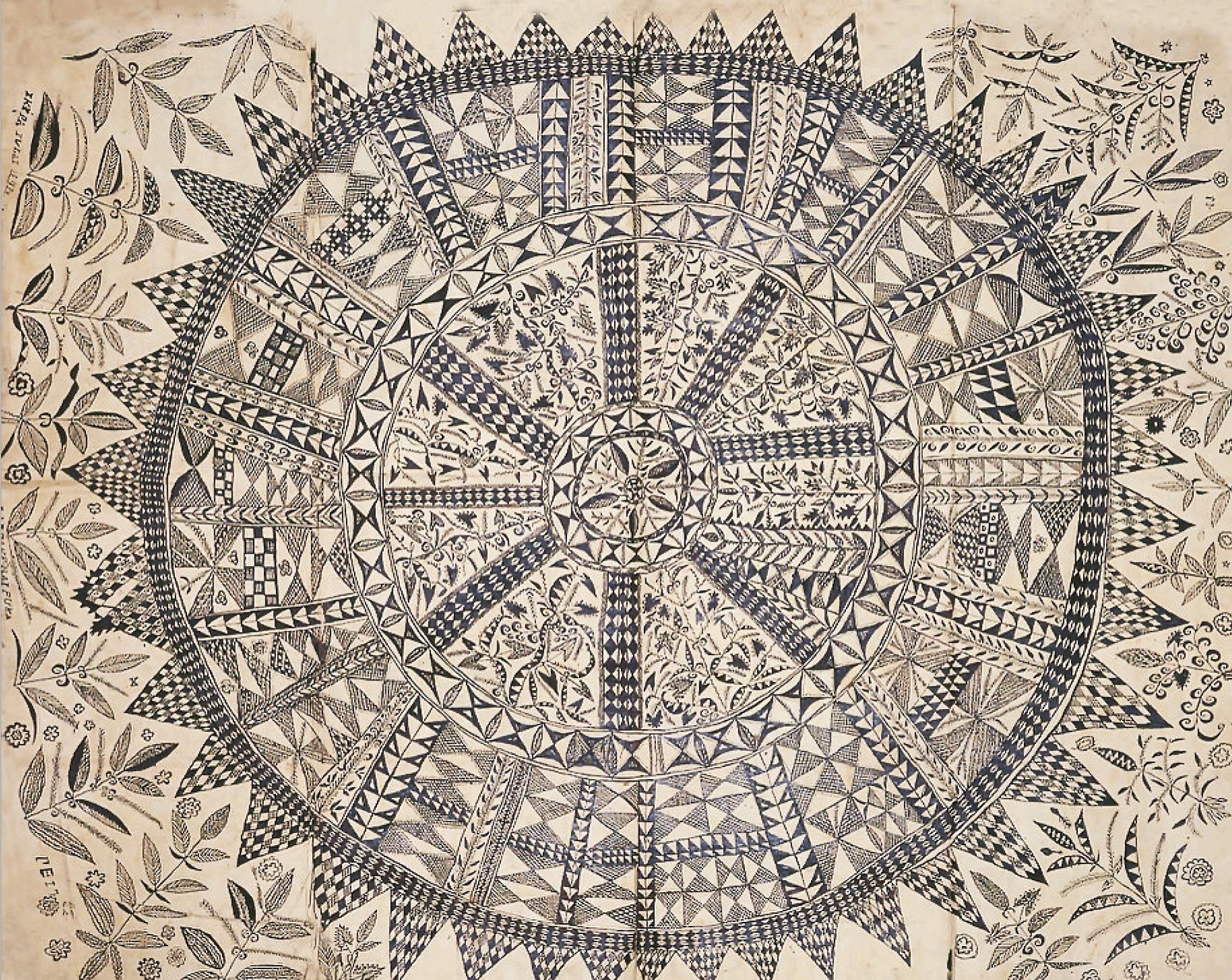
Hiapo (tapa) c. 1850–1900 C.E. Tapa or bark cloth, freehand painting.
Pacific - Niue
Polynesia
Belief in mana
Made to protect the mana of an object or diety (spirit of somebody)
Made freehand by all of the women in the tribe, beaten down to soften by men
All women of the tribe would make it together and then give it to one person
Themes: Community
Connections: Staff God, Moai Figures?

Staff God. Rarotonga, Cook Islands, central Polynesia. Late 18th to early 19th century C.E. Wood, tapa, ber, and feathers.
Pacific - Cook Islands
Representations of the deities worshipped by Cook Islanders
Sacred item of worship
Community-based piece → men would carve, women would wrap in cloth
Themes: Sexual, reproduction, community
Connections: Hiapo Cloth
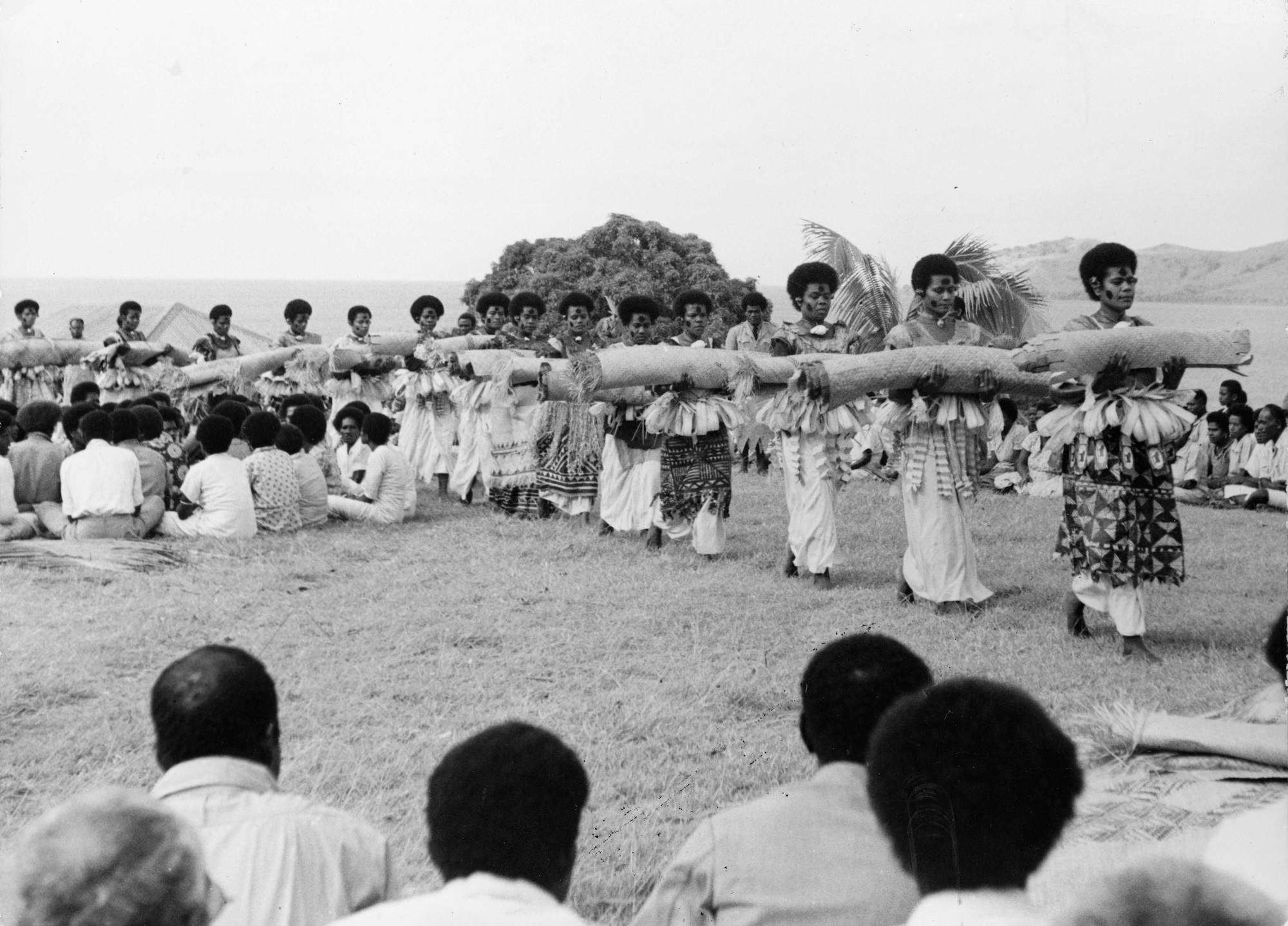
Presentation of Fijian mats and tapa cloths to Queen Elizabeth II. Fiji, Polynesia. 1953 C.E. photographic documentation.
Pacific - Fiji
Historical documentation of an important moment
Big deal → first time ever any European royalty came to Fiji
Learning source of Fijian culture
Themes: History, photograph
Connections: Tamati Waka Nene, The Steerage

Tamati Waka Nene. Gottfried Lindauer. 1890 C.E. Oil on canvas.
Pacific - Maori
Reliquary figure
Maori chief who was important war hero
Maori tattoo → moko, mana
Eye on staff made of jade → shows he was wealthy and also “all-seeing” eye
Passed down through families
Had to be finished wihtin 2 months of death in order to catch the spirit
Realistic rendering → most realistic portrait in early artwork
Archaic smile
Big deal if destroyed because its like destroying the actual person
Themes: Afterlife, spirituality, important people
Connections: Moai figures, Female Diety, other paintings in Europe
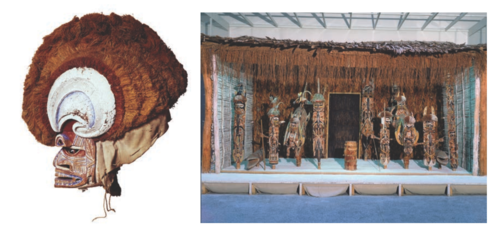
Malagan display and mask. New Ireland Province, Papua New Guinea. c. 20th century C.E. Wood, pigment, ber, and shell.
Pacific - Cook Islands
Made for one occasion then destroyed
Colorful, intricately carved
Had ownership (copyright)
Made for Malagan (a cycle of rituals of the people)
Honors and dismisses the dead
Themes: Death, afterlife, rituals, spirituality
Connections: Buk Mask, other African masks
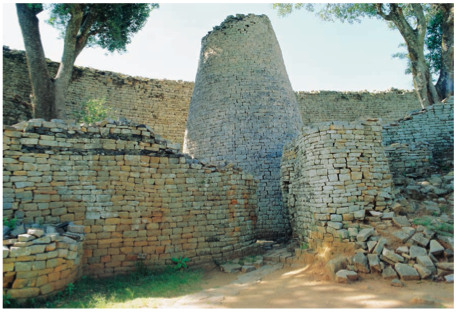
Conical tower and circular wall of Great Zimbabwe. Southeastern Zimbabwe. Shona peoples. c. 1000–1400 C.E. Coursed granite blocks.
Africa - Shona Peoples
To worship the god Mwari
Maybe a grainery → distributed grain as a way of showing protection
Political center where they governed the kingdom
Symbol of royal authority and generosity
Themes: Connection, honor, community
Connections: Athenian Agora, Macchu Pichu, Mesa Verde, Nan Madol
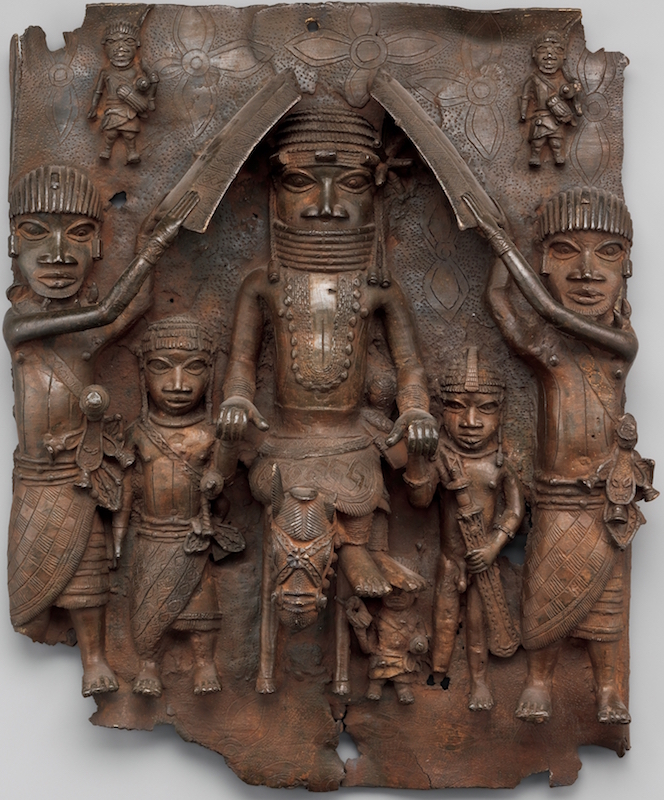
Wall plaque, from Oba’s palace. Edo peoples, Benin (Nigeria). 16th century C.E. Cast brass.
Africa - Edo Peoples
Oba: King
Depicts Oba and his attendants from the Benin Empire
Hierarchy of scale
Artist’s gaze
Intensity of graming
Key historic records for the Benin court and kingdom
Made with lost wax technique
Originally hung with others throughout palace of Oba → the sequence of the plaques would have told us the order of the royal lineage of Benin’s Obas
Themes: Power/authority, Human figure, Social status
Connections: Seated Boxer, Doryphoros, Tamati Waka Nene, Augustus of Primaporta
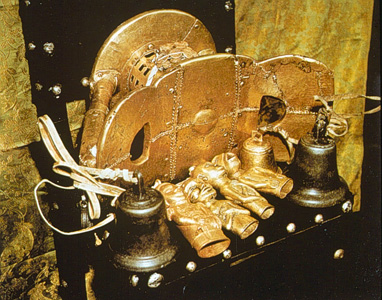
Sika dwa ko (Golden Stool). Ashanti peoples (south central Ghana). c. 1700 C.E. Gold over wood and cast-gold attachments.
Africa - Ashanti Peoples
Throne for the Ashtani People
Housed the spirits (living, dead, future) of the Ashanti
Symbol of the people
Only the king can sit on it when in rule
Displays influence of the king
Bells warn of danger
Tipped sideways in pictures to represent family practices
Themes: Reliquary object, power, culture
Connections: Votive Figures, King Tutankam’s Tomb
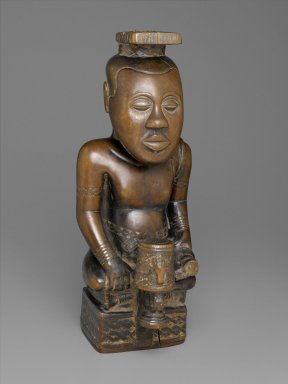
Ndop (portrait gure) of King Mishe miShyaang maMbul. Kuba peoples (Democratic Republic of the Congo). c. 1760–1780 C.E. Wood.
Africa - Kuba Peoples
Normally portrayed the ruler carrying a weapon in his hand, frequently a peace knife
All Ndop figures featured a geometric motif and an emblem
Believed the Ndop housed the Nyim’s double, the counterpart of his soul
Comissioned by the king to celebrate his regime and accomplishments
1-3 proportions
Some naturalistic features
Themes: Power, authority in culture
Connections: Reliquary Gure, Power Gure, Female Deity
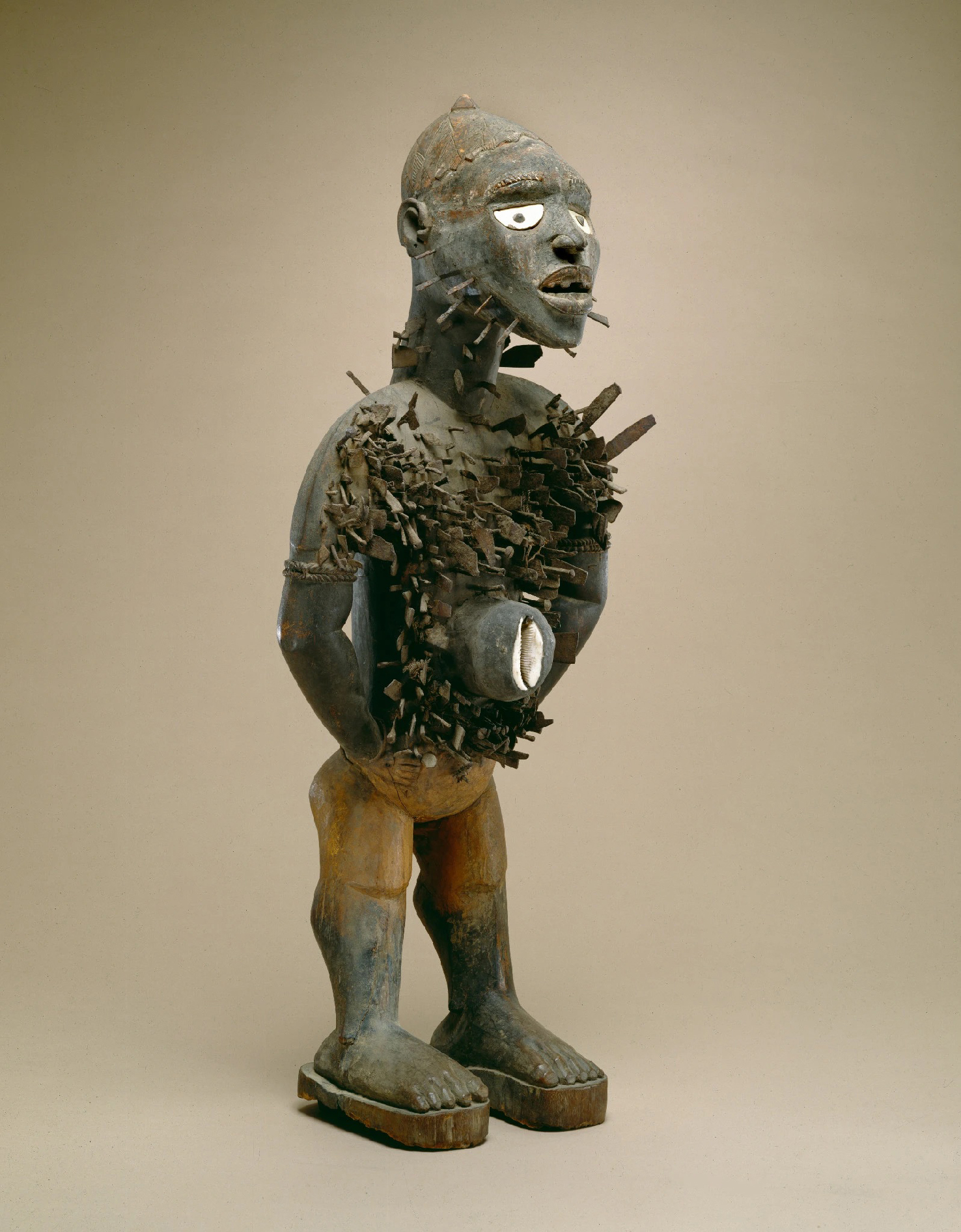
Power Gure (Nkisi n’kondi). Kongo peoples (Democratic Republic of the Congo). c. late 19th century C.E. Wood and metal.
Africa - Kongo Peoples (DRC)
Reliquary figure → holds someone’s soul
Glass on stomach represents “other world”
Would have been activated through chants and rituals
When something is put in its stomach → activated
Seek solutions to problems → hammers nails into its skin
When activated, goes after the evil doers
Themes: Spirituality, order, justice, violence
Connections: Tamati Waka Nene, Jade Cong, Maoi on Platform
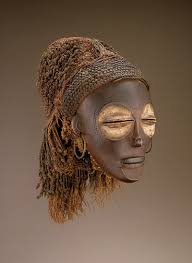
Female (Pwo) mask. Chokwe peoples (Democratic Republic of the Congo). Late 19th to early 20th century C.E. Wood, ber, pigment, and metal.
Africa - Chokwe Peoples
Regarding feminine beauty
Represents an ideal woman to the man
Male initiation - men perform masquerade dance
Women inspire the mask but have no part in wearing or creating
Resembles a woman in the community that he admires
Honors women of the community (especially mothers and those who have recently gone through childbirth)
Themes: Coming of age, female beauty, community, role of women
Connections: Portrait Mask, Transformation Mask, Peblos Kore?
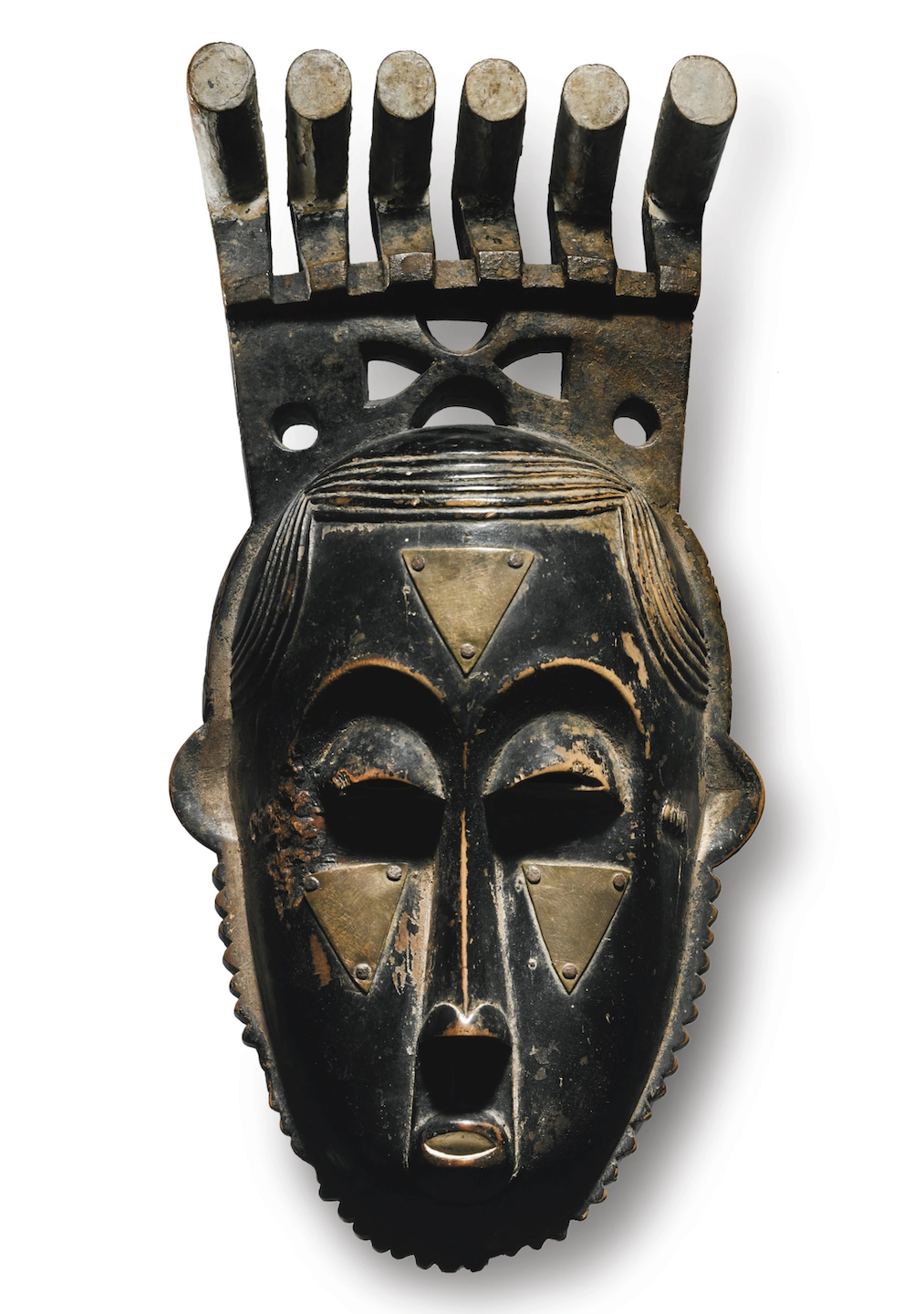
Portrait mask (Mblo). Baule peoples (Côte d’Ivoire). Early 20th century C.E. Wood and pigment.
Africa - Baule Peoples
Can be worn by women
Honors a specific woman
Can be passed down
Used in performances for entertainment
Enable communication with ancestors
Elements of the mask symbolize modesty, wisdom, and age
Themes: Identity and honor, community and social life, cultural heritage
Connections: Transformation Mask, Buk Mask, Female (Pwo) Mask
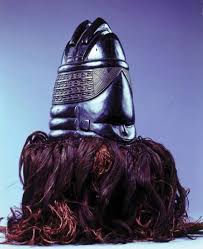
Bundu Mask. Sande Society, Mende peoples (West African forests of Sierra Leone and Liberia). 19th to 20th century C.E. Wood, cloth, and ber.
Africa - Mende Peoples, Sande Society
Small mouth and ears → not gossiping or listening to gossip
Closed eyes → being peaceful
Worn by women
Thought to actually be a spirit
When it had the raffia, it was important, but outside of the rituals, it’s just regarded as a piece of wood
Shaped like a chrysalis → not yet a butterfly but no longer a caterpillar
Part of public masquerade that celebrates girl’s maturation
Rings around neck represent fertility, good health, high status
Themes: Spirituality, womanhood, tradition
Connections: Female (Pwo) Mask, Aka Elephant Mask

Ikenga (shrine gure). Igbo peoples (Nigeria). c. 19th to 20th century C.E. Wood. 177.
Africa - Igbo Peoples
Most commonly a seated male
Sitting → in reverence, humble pose
Horns represent determination
Knife in one hand → challenges one will meet
Human head in other → mastery over opponents
When Igbo male comes of age, they are given an Ikenga
When the owner dies, the Ikenga is broken and buried with them
Signifies owner’s potential for success and control of fate
Individualized for each person
Very elaborately carved
Themes: Potential, honor, commitment, individuality
Connections: Votive Figures, Power Pigure, Female Deity
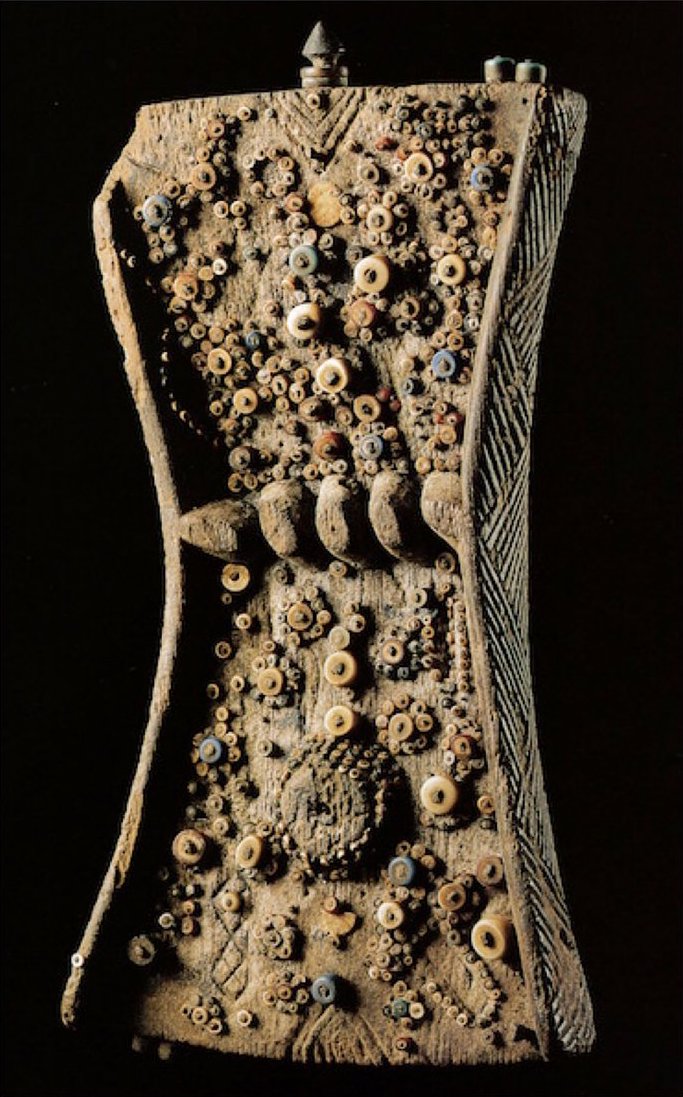
Lukasa (memory board). Mbudye Society, Luba peoples (Democratic Republic of the Congo). c. 19th to 20th century C.E. Wood, beads, and metal.
Africa - Luba Peoples (DRC)
Helps people create a collective memory of the society
Abstract arrangement of symbols that represent the political and historical events
Really the only people who could read it were the person who made it or the people who’ve been told and passed down
Themes: Memory, kinship, legacy, storytelling
Connections: Navigation Charts, Painted Elk Hide, Last Judgement of Hunefer
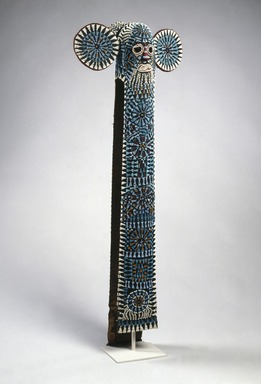
Aka elephant mask. Bamileke (Cameroon, western grasslands region). c. 19th to 20th century C.E. Wood, woven raffia, cloth, and beads.
Africa - Bamileke
Danced by the members of the Elephant Society
The Fon (king) could transform into the elephant → connections between divine rule and power animals
To honor king and bring out social harmony
The leopard and elephant are symbols of the Fon’s power
Main form: isosceles triable which relates to the patterning of the body of a leopard
Themes: Power/authority, culture, tradition, celebration, spirituality
Connections: Bandolier Bag, Ruler’s Feather Headress, other African masks
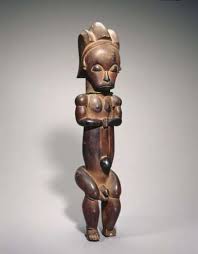
Reliquary Gure (byeri). Fang peoples (southern Cameroon). c. 19th to 20th century C.E. Wood.
Africa - Fang Peoples
Reliquary figure
Talisman: an object with supernatural powers to protect against evil and give good luck
Muscles show power and strength
Capture sense of vitality
Belly button → shows rebirth
To protect the remains of dead people of high status
To ward off evil and protect box filled with bones of important members
Elongated skull → wisdom
Themes: Death, rebirth, ancestry, protection, afterlife
Connections: Votive Figures, Moai on Platform, Power Figure
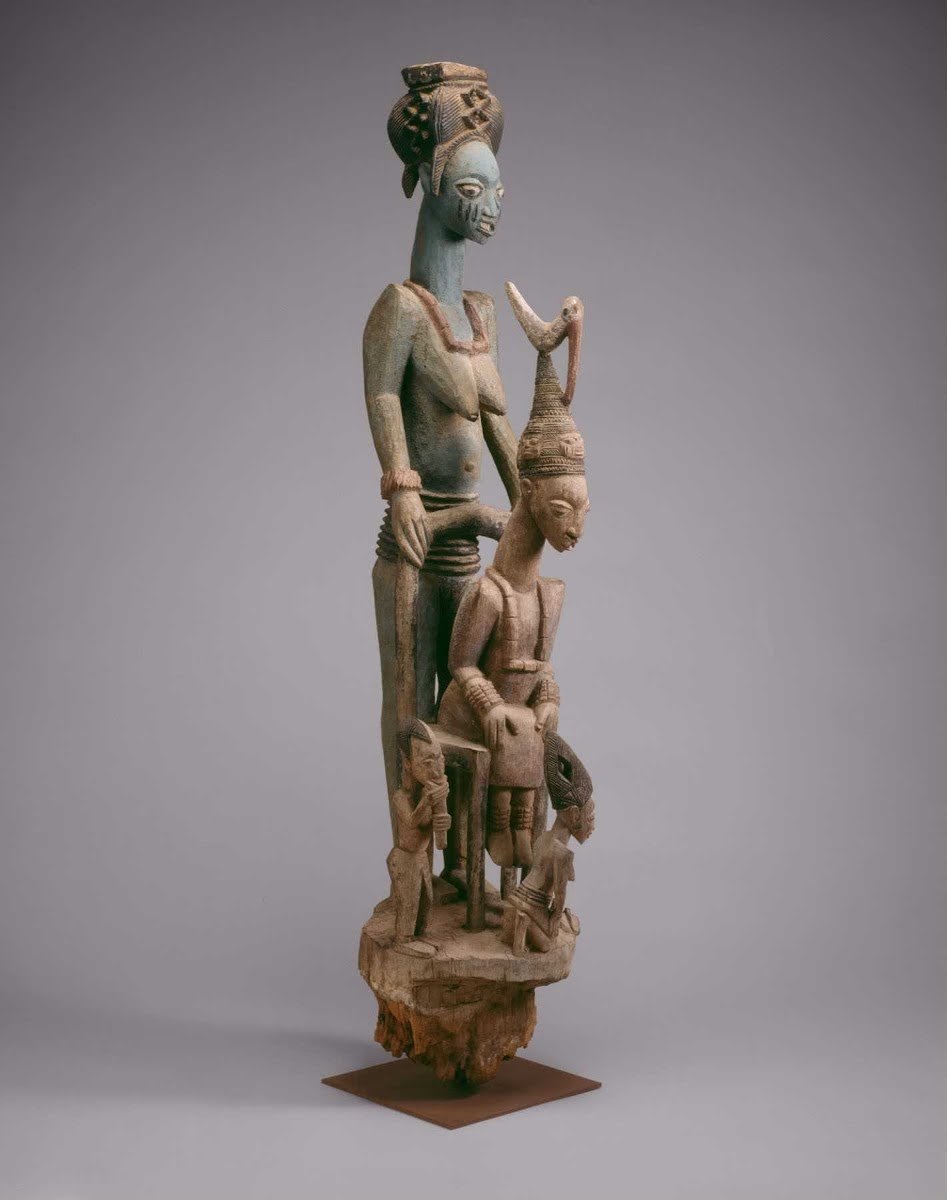
Veranda Post of Enthroned King and senior wife (Opo Ogoga). Olowe of Ise (Yoruba peoples). c. 1910–1914 C.E. Wood and pigment.
Africa - Yoruba Peoples
Veranda post: structural post for a palace
Commissioned for a principal entryway (1 of 5 veranda posts)
Hierarchy of scale
Seated king accompanied by his consort
Themes: Gender roles (patriarchy), transcendence, power/authority, tradition
Connections: King Menkure and Queen (both show men of an equal status), Lamassu Figures

Chavín de Huántar. Northern highlands, Peru. Chavín. 900–200 B.C.E. Stone (architectural complex); granite (Lanzón and sculpture); hammered gold alloy (jewelry).
Indigenous America - Chavín
Symbol of jaguars → ultimate power
Totems have mixture of human and animal features
Important pilgrimage site that drew people and their offerings from far and wide
Constructed for a god, and is represented in the Lanzón (wedge-shaped stone)
Themes: Religion/tradition, heaven & earth, nature & man, fertility
Connections: Nan Madol, Yaxchilán, Audience Hall of Darius and Xerxes, Pyramids of Giza, Agora, Templo Mayor
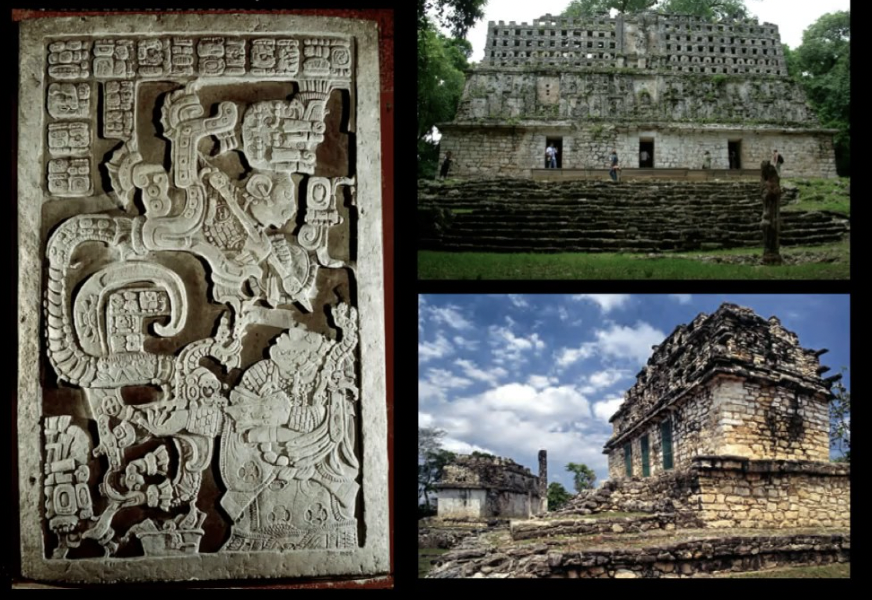
Yaxchilán. Chiapas, Mexico. Maya. 725 C.E. Limestone (architectural complex).
Indigenous America - Maya
Collection of ruins/architectural complex
Had relief sculptures: lintels, hieroglyphic writing, carvings, stele
Built next to a river and surrounded by dense jungle
Honoring Lady Xoox (shield Jaguar II honoring his wife)
Functions as a shelter and as a complex for life
Themes: Culture, honoration, bloodletting
Connections: Nan Madol, Chavín de Huántar, Machu Pichu, TemploMayor
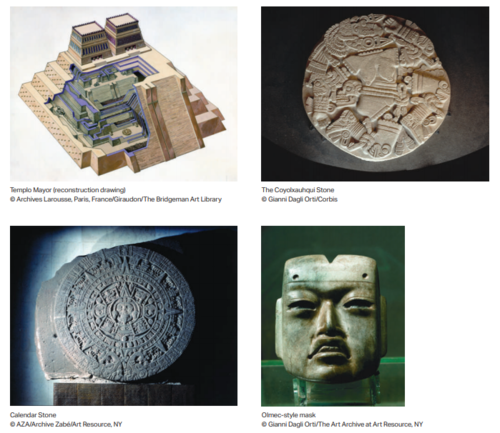
Templo Mayor (Main Temple). Tenochtitlan (modern Mexico City, Mexico). Mexica (Aztec). 1375–1520 C.E. Stone (temple); volcanic stone (The Coyolxauhqui Stone); jadeite (Olmec-style mask); basalt (Calendar Stone).
Indigenous Americas - Aztec
2 twin temples (Tlaloc - god of rain, Huitziapohitie - god of war)
Positioned at center of the Mexican capital (Mexica Cosmos)
Coyolxauhqui Stone: Served as a decoration in the god of war temple, originally brightly painted, pinwheel-shaped monolith carved in low relief
Calendar Stone: Served the purpose of being an astronomical and timekeeping device, central image depicts either the sun deity or heart god
Themes: Sacrifice/ritual, worship, power and submissions (to Mexican government), Deities
Connections: Great Pyramids, Audience Hall of Darius and Xerxes, Chavín de Huántar
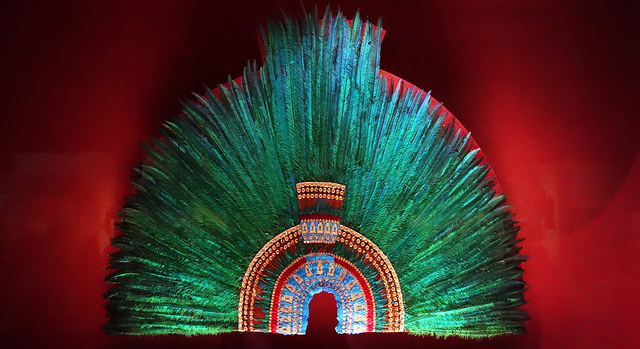
Ruler’s feather headdress (probably of Motecuhzoma II). Mexica (Aztec). 1428–1520 C.E. Feathers (quetzal and cotinga) and gold.
Indigenous Americas - Aztec
Worn as a hat/crown
Sometimes put on for rituals or performances
Made of exotic bird feathers
Themes: Celebration, religion, pride
Connections: Buk Mask, Elephant Mask, Ahu’ula, Templo Mayor

City of Cusco, including Qorikancha (Inka main temple), Santo Domingo (Spanish colonial convent), and Walls at Saqsa Waman (Sacsayhuaman). Central highlands, Peru. Inka. c. 1440 C.E; convent added 1550–1650 C.E. Andesite.
Indigenous Americas - Inka
Old city is shaped like a puma
Divided in quarters → reflected the 4 divisions of the Inka empire → city was a miniature of Inka mape of Inka empire
Qorikancha: most important temple in the Inka empire, used to pay tribute to their gods, doorways double jammed to signify importance of the building
Themes: Power, Religion
Connections: Athenian Agora, Machu Pichu, Acropolis

Maize cobs. Inka. c. 1440–1533 C.E. Sheet metal/repoussé, metal alloys.
Indigenous Americas - Inka
Repoussé
Little, realistic metallic gifts used by the Inka in rituals that benefited both their state region and government
Inka visual expression was representational, incorporating more naturalistic forms in small-scale metal objects
Themes: Agriculture, nature, power and authority, religion
Connections: Merovingian Looped Fibulae, Claus Odenurg works
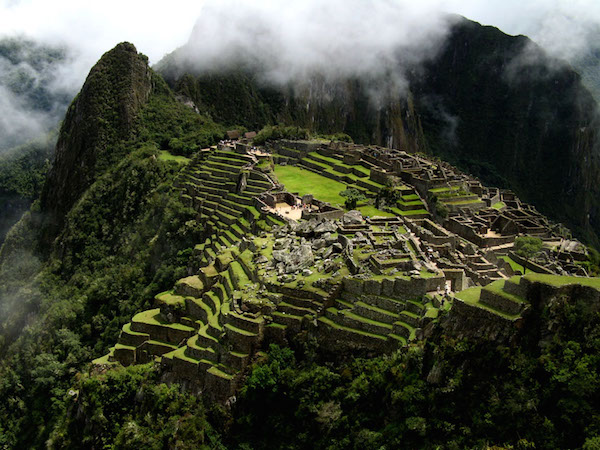
City of Machu Picchu. Central highlands, Peru. Inka. c. 1450–1540 C.E. Granite (architectural complex).
Indigenous Americas - Inka
Site chosen for its relationship to the Andean mountains, which have long been considered ancestral deiteis through the Andes
Built as a royal estate for the first Inka emperor
Intended as a place where the Inka emperor and his family could host feasts, perform religious ceremonies, and administer the affairs of the kingdom
Entryways: unique Inka shape of a trapezoid
Themes: Wealth, power, agriculture, religion
Connections: Chavín de Huántar, Nan Madol, Mesa Verde, Stonehenge

All-T’oqapu tunic. Inka. 1450–1540 C.E. Camelid ber and cotton.
Indigenous Americas - Inka
Finely made textiles made from the best materials were objects of high status and much more valuable than gold or gems
Finest textiles and cloth were produced by acllas (women who were collected from across the empire to make them)
T’oqapu: the square geometric motifs, only worn by those of high rank
Sapa Inka: Inka ruler
Made using backstrap looms
Functioned as a royal tunic
Represented the social and political power of the Sapa Inka
Themes: Power, royalty, politics
Connections: Ahu’ula, Ruler’s Feather Headdress
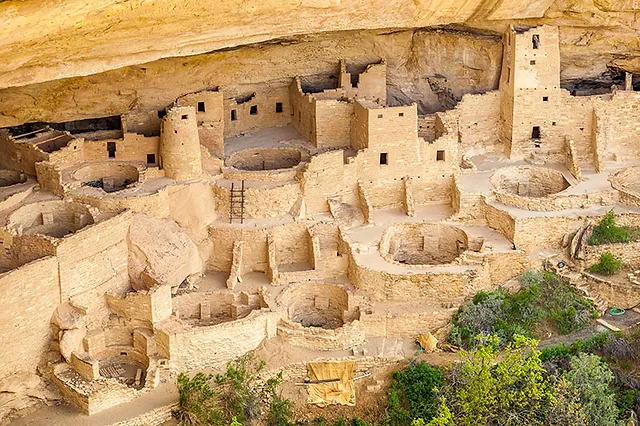
Mesa Verde cliff dwellings. Montezuma County, Colorado. Ancestral Puebloan (Anasazi). 450–1300 C.E. Sandstone.
Indigenous Americas - Ancestral Pueblan
Accessed these dwellings with retraceable ladders
Mostly residential structures but some were used for ritual
Kiva: circular, subterranean rooms used for ceremonies
Themes: Nature v man, community, spirituality, agriculture
Connections: City of Machu Picchu, Nan Madol, Athenian Agora
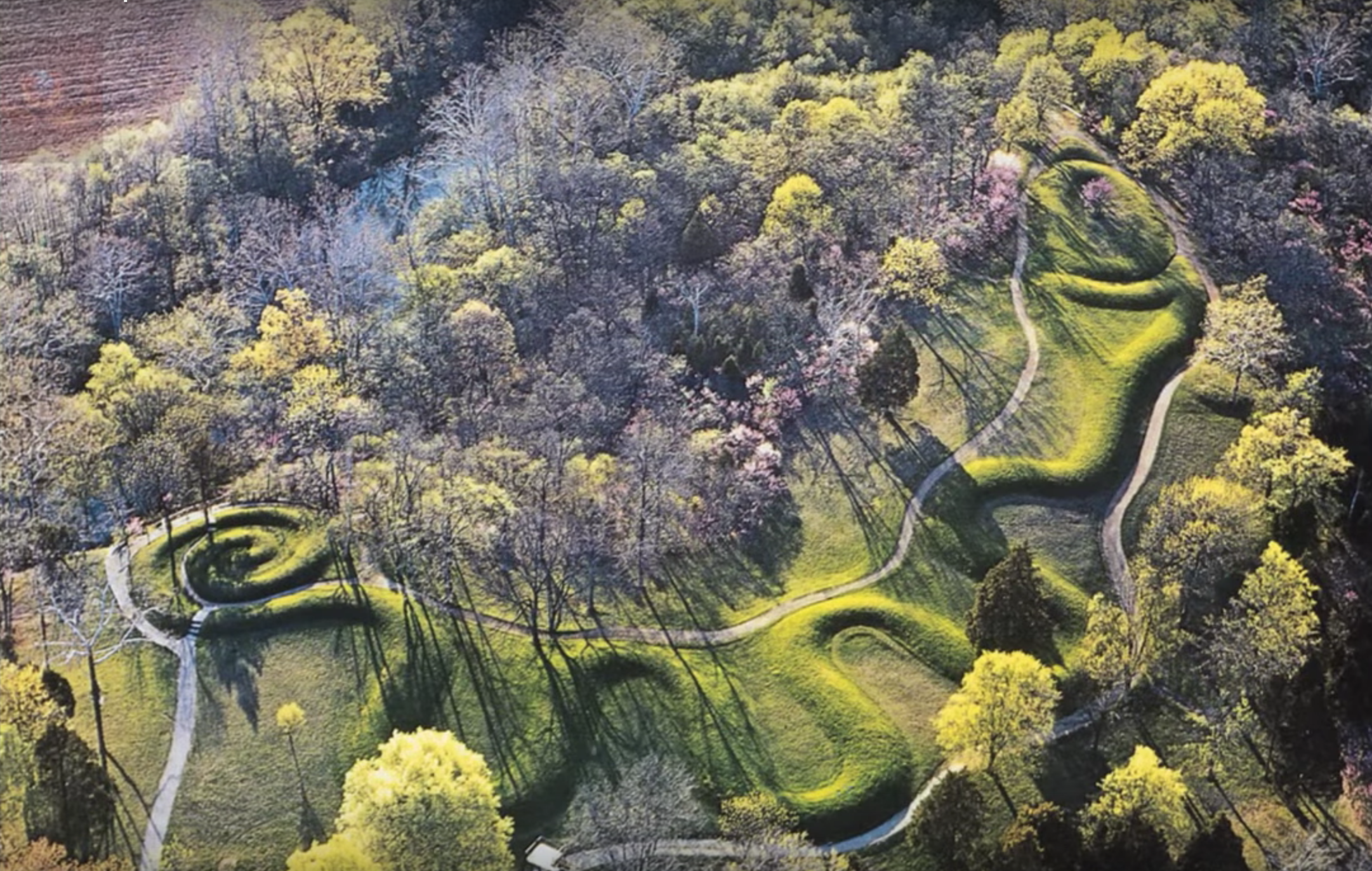
Great Serpent Mound. Adams County, southern Ohio. Mississippian (Eastern Woodlands). c. 1070 C.E. Earthwork/ef gy mound.
Indigenous Americas - Missippian
Largest serpent effigy (sculpture/model) in the world
Possible astronomical functions
Head of serpent aligns with the summer solstice, tail aligns with the winter solstice at sunrise
Zoomorphic
Themes: Spirituality, symbolism, mythology, astronomy
Connections: Stonehenge, Templo Mayor
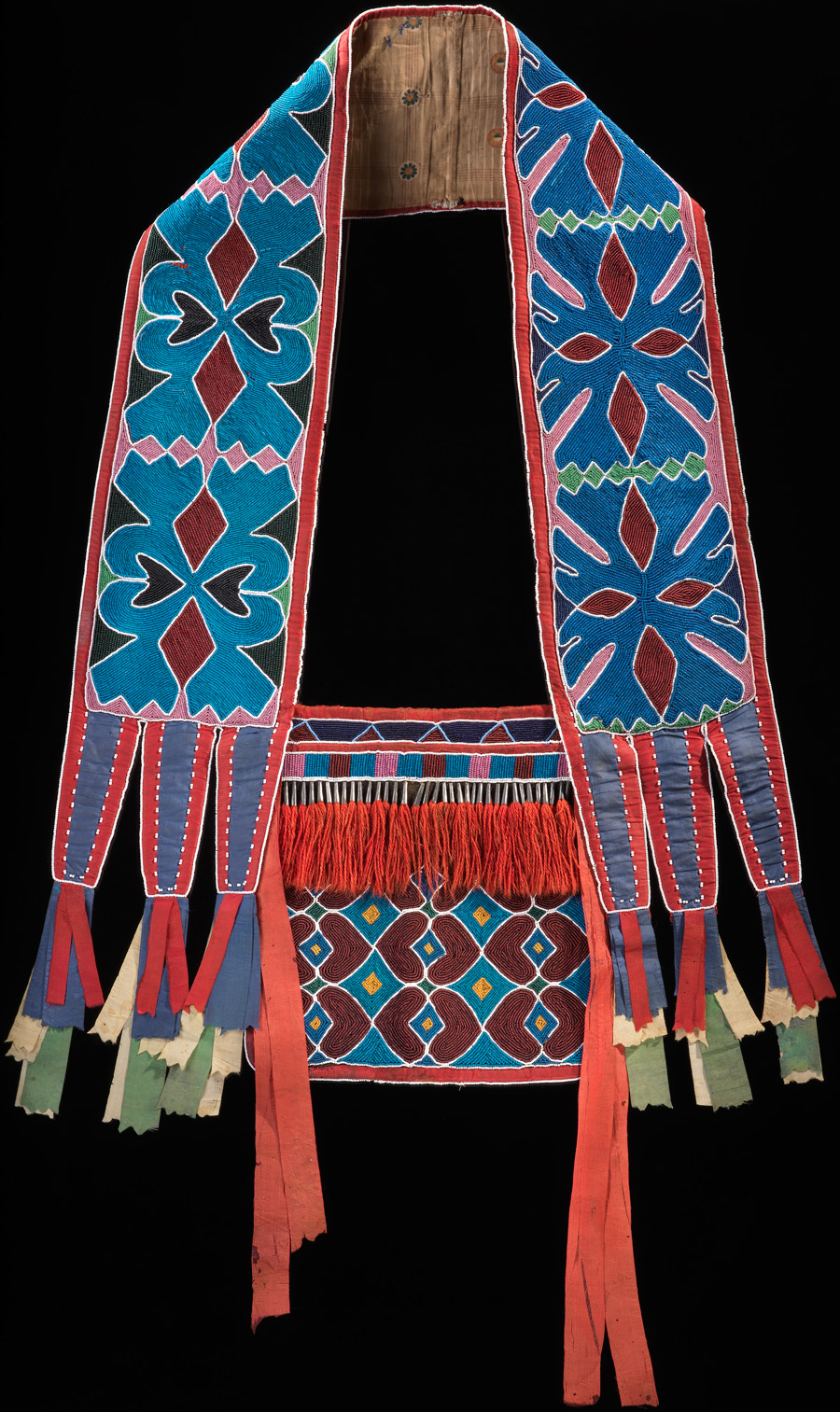
Bandolier bag. Lenape (Delaware tribe, Eastern Woodlands). c. 1850 C.E. Beadwork on leather.
Indigenous Americas - Delaware
Primarily to complete the ceremonial outfits worn by men
Copied from those used by European soldiers to carry cartridges for their rifles
Didn’t carry anything in them; mainly for fashion
Abstract and symmetrical designs
Themes: Wealth/status, beliefs, balance/duality, adornment, beauty
Connections: Feather Cape, Old Man’s Cloth, Aka Elephant Mask
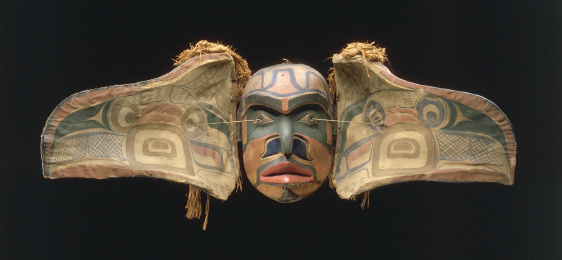
Transformation Mask. Kwakwaka’wakw, Northwest coast of Canada. Late 19th century C.E. Wood, paint, and string.
Indigenous Americas - Kwakwaka’wakw (in Canada)
When cords are pulled, mask opens → sense of movement
When opened, eagle’s face and beak are split and represent a bird spreading its wings
Reveals the face of an ancestor
To manifest transformation
Worn by dancers during ceremonies
Bilaterally symmetrical
Themes: Manifestation, Tradition, Culture, Coexistence
Connections: Buk Mask, Female (Pwo) Mask, other African masks

Painted elk hide. Attributed to Cotsiogo (Cadzi Cody), Eastern Shoshone, Wind River Reservation, Wyoming. c. 1890–1900 C.E. Painted elk hide.
Indigenous Americas - Eastern Shoshone
Buffalo hunt with Thunder on horseback with rifles
Camp scene
Displays elements of several different dances (Sun Dance, Wolf Dance, Grass Dance)
To portray Shoshone life
Used as robes or for teepee walls
Themes: Spiritual, ritual, nature, animals, legacy, storytelling
Connections: Darkytown Rebellion, Running Horned Woman, Apollo 11 Stones

Black-on-black ceramic vessel. Maria Martínez and Julian Martínez, Tewa, Puebloan, San Ildefonso Pueblo, New Mexico. c. mid-20th century C.E. Blackware ceramic
Indigenous Americas - Puebloan
Perfectly symmetrical
Geometric shapes
Used for food storage, cooking, ceremonies, and decoration
Themes: Community, Appreciation for art
Connections: Mesa Verde, Bandolier Bag
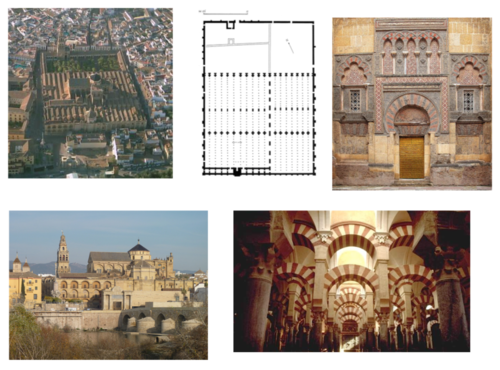
Great Mosque. Córdoba, Spain. Umayyad. Begun c. 785–786 C.E. Stone masonry. Pyxis of al-Mughira. Umayyad. c. 968 C.E. Ivory.
Islamic Spain
Space added onto at least 3 times
Kept adding onto the arches, creates illusion of infinite space
Transformed from a Roman temple dedicated to Tanus into a mosque
Orange trees in courtyard symbolize Umayyad's legacy
Significant religious and architectural center during Muslim rule in Al-Andalus
Features a large hypostyle prayer hall characterized by its repressed geometric patterns and symmetrical arches
Architectural elements recycled Roman columns
Themes: Religion, symmetry, cultural influence, prayer & reflection
Connections: Hagia Sophia, Kaaba, Greate Mosque of Djenne
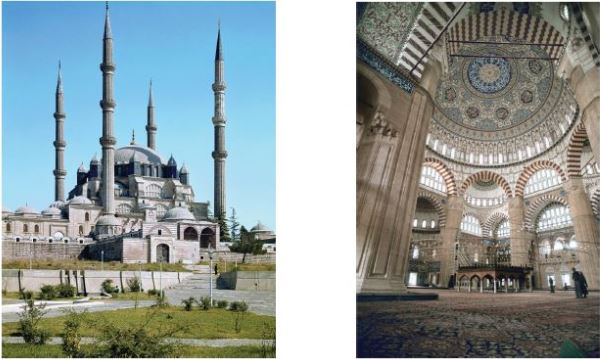
Mosque of Selim II. Edirne, Turkey. Sinan (architect). 1568–1575 C.E. Brick and stone.
Islamic
Built in Edirne instead of Istanbul (capital of Turkey) so that the mosque could be the focus of the city
To prove that architecture could surpass Hagia Sophia
Octagonal dome
Themes: Religion, Conquest, Architecture
Connections: Great Mosque of Djenne, Hagia Sophia, Great Mosque of Córdoba

Great Mosque of Djenné. Mali. Founded c. 1200 C.E.; rebuilt 1906–1907. Adobe.
Islam in Africa
Unique → being rebuilt constantly
Ostrich eggs on roof symbolize fertility and purity
Became a center of religious and cultural life in Mali
Used as a center of learning, culture, commerce, and Islam
Largest built mud structure in the world
Traditional, all-natural materials
Themes: Fertility, culture, Islam, religion, education
Connections: Sunflower Seeds, Nan Madol, Templo Mayor (religious), others from pacific unit (organic materials)
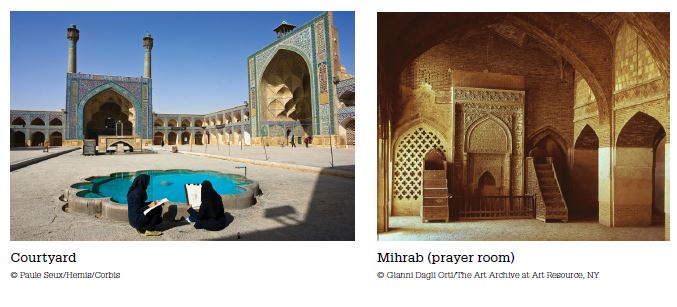
Great Mosque (Masjid-e Jameh). Isfahan, Iran. Islamic, Persian: Seljuk, Il-Khanid, Timurid and Safavid Dynasties. c. 700 C.E.; additions and restorations in the 14th, 18th, and 20th centuries C.E. Stone, brick, wood, plaster, and glazed ceramic tile.
Islamic
Designed around courtyard
More than a place of prayer → community center
Hypostyle interior (roof supported by many pillars)
Underside of dome has detailed geometric patterns
Themes: Islamic architecture, symmetry & geometry, cultural fusion, community, religion
Connections: Athenian Agora, other mosques

The Kaaba. Mecca, Saudi Arabia. Islamic. Pre-Islamic monument; rededicated by Muhammad in 631–632 C.E.; multiple renovations. Granite masonry, covered with silk curtain and calligraphy in gold and silver-wrapped thread.
Islamic
Only Muslims may visit
Muslims walk around it and make Tawaf
Holy site for Muslim pilgrimage
marks the direction that all Muslims should pray towards
Cubical structure
Kiswa → large cloth that covers Kaaba
Arabic writing on exterior
Themes: Religion, faith, culture, pilgrimage, community
Connections: Other mosques
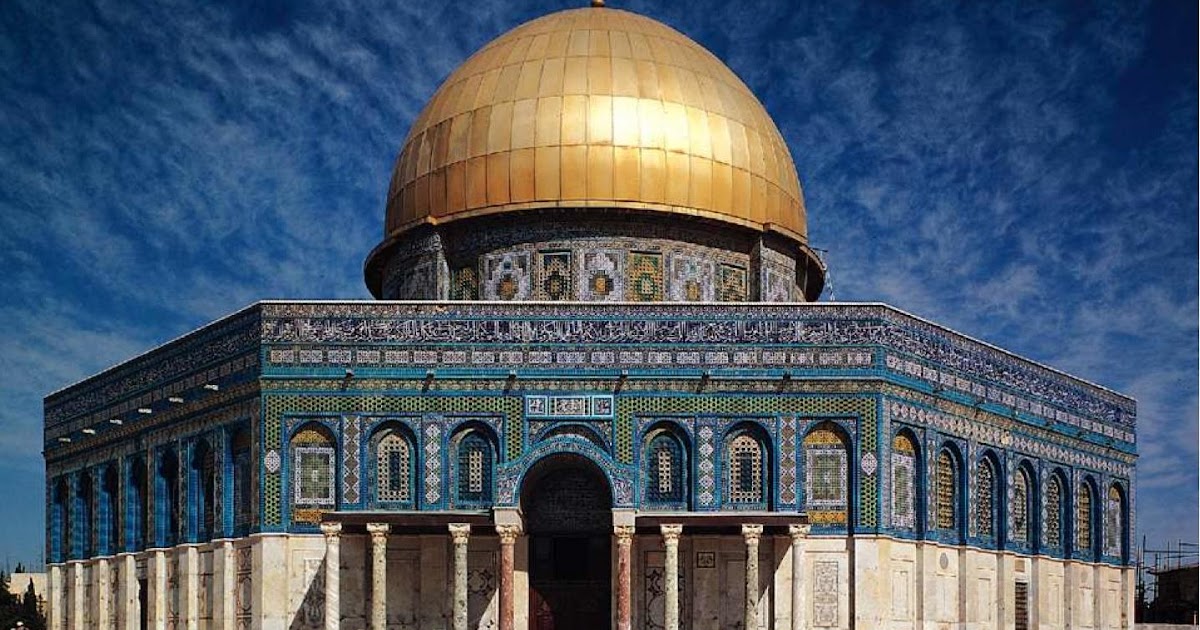
Dome of the Rock. Jerusalem. Islamic, Umayyad. 691–692 C.E., with multiple renovations. Stone masonry and wooden roof decorated with glazed ceramic tile, mosaics, and gilt aluminum and bronze dome.
Islamic
Incredibly ornate, detailed, and mathematically precise
Golden dome
Outside is an octagon
Islam: Muhammad (PBUH) was called to ascend and learn how to pray
Judaism: Abraham was asked by God to sacrifice his son → place where he sacrificed his son
Themes: Religion, faith, war
Connections: Hagia Sophia, Pantheon, Great Stupa at Sanchi
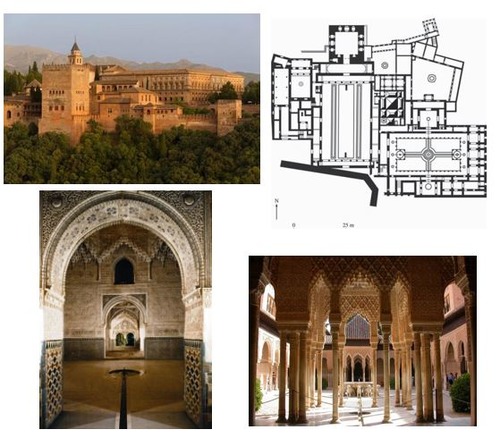
Alhambra. Granada, Spain. Nasrid Dynasty. 1354–1391 C.E. Whitewashed adobe stucco, wood, tile, paint, and gilding.
Islamic Spain
Place of religious reflection
Residence for ruler and close family
Lots of intricate carvings
Induces calming/meditative effect
Themes: Religion, cultural mixing, symmetry, patterns, detail
Connections: Taj Mahal, Acropolis, Great Mosque, Kaaba, Forgotten City

Taj Mahal. Agra, Uttar Pradesh, India. Masons, marble workers, mosaicists, and decorators working under the supervision of Ustad Ahmad Lahori, architect of the emperor. 1632–1653 C.E. Stone masonry and marble with inlay of precious and semiprecious stones; gardens.
Islamic
Incredibly symmetrical
Shah Jahan created as a tomb and a place to remember and honor his wife Mumtaz Mahal
Hasht Bihisht (8 levels) principle, alluding to the 8 levels of paradise
Red sandstone gate inlaid with precious stones and carved with a lot of detail
Themes: Death, spirituality, honor, life, religion
Connections: The Great Pyramids, Palace of Versailles, Dome of the Rock, Great Mosque of Salim

Basin (Baptistère de St. Louis). Muhammad ibn al-Zain. c. 1320–1340 C.E. Brass inlaid with gold and silver.
Islamic
Embodies cross-cultural roots with Islamic world and medieval Europe → depicts soldiers, horsemen, birds
Outer band: depicts a finely crafted procession of Mamluk emirs among mace-bearer
Created by Mamluks (known as extraordinary craftsmen)
Symbolizes the influence of Europan aesthetics on Islamic art
Ritual washing bowl in the Mamluk court → used to baptize children of the royal family
Original purpose unknown
Symmetrical with repetition of motifs and figures
Themes: Wealth, culture, power/authority, beauty
Connections: Taj Mahal

The Ardabil Carpet. Maqsud of Kashan. 1539–1540 C.E. Silk and wool.
Islamic
Carpets were important to Islamic arts and served as a trade item
Name is inspired from a city in north-eastern Iran - Ardabil
Geometric and floral patterns
Themes: Tradition, celebration, life, death, history, religion
Connections: All-T’oqapu Tunic, Bayeux Tapestry, Painted Elk Hide, Tiapo (Tapa), Dancing in the Louvre

Bahram Gur Fights the Karg, folio from the Great Il-Khanid Shahnama. Islamic; Persian, Il’Khanid. c. 1330–1340 C.E. Ink and opaque watercolor, gold, and silver on paper.
Islamic Manuscript
A book illustration depicting one of the many stories from Shahnama, the Persian Book of Kings
Illustrates the power of the Il’Khanid King of the area at the time
To help illustrate the story, which was a famous epic poem
King wearing material from Europe, painted using Chinese styles
Themes: Heroism, bravery, triumph, violence, kingship
Connections: Great Hall of the Bulls, Painted Elk hide, Foli from a Quran, Court of Gayumars, Jahangir Preferring a Su Shaikh to Kings
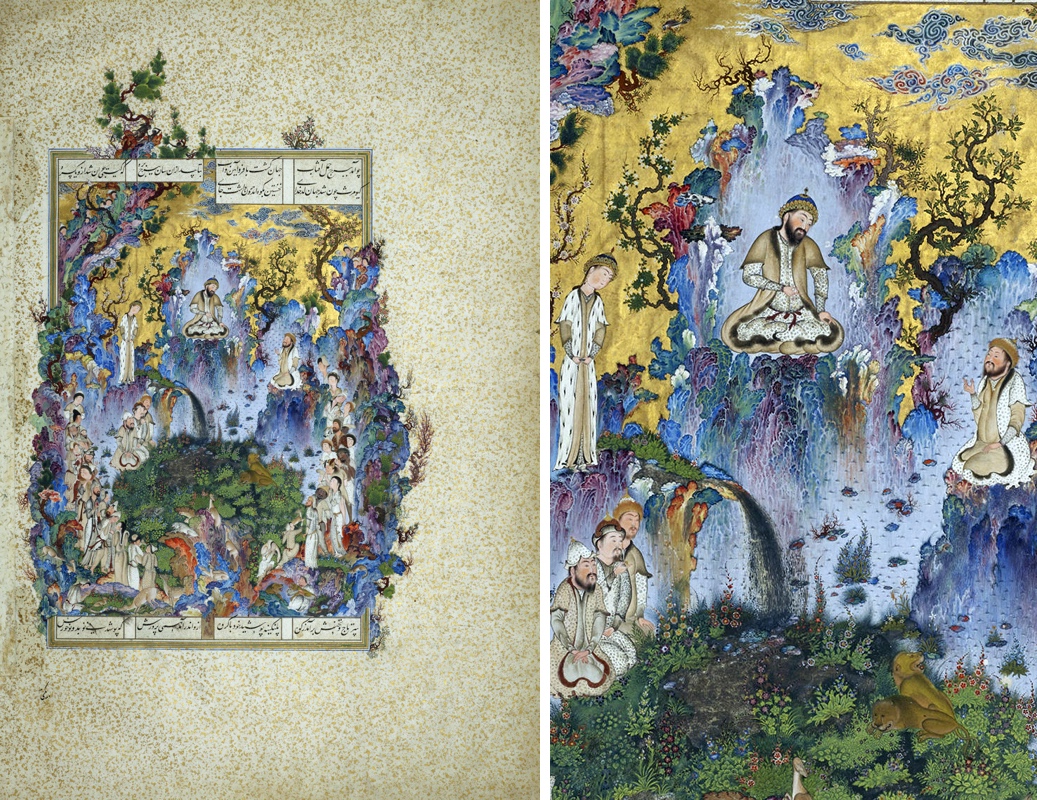
The Court of Gayumars, folio from Shah Tahmasp’s Shahnama. Sultan Muhammad. c. 1522–1525 C.E. Ink, opaque watercolor, and gold on paper.
Islamic Manuscript
Depicts history of Persia
Peaceful and colorful scene with central figure
1st king of Persia (Gayumar) is drawn overlooking his court
On cliff beside him are his son and grandson
Part of the Shahnama (Persian Book of Kings)
To absorb and enchant the viewer
To illustrate the story of the great king Gayumars (whom animals and humans alike obeyed)
Arranged on vertical axis
Goes outside of margins
Hierarchy of scale
Themes: Love, suffering, death, harmony, influence of Chinese art
Connections: Bahram Gur Fights the Karg
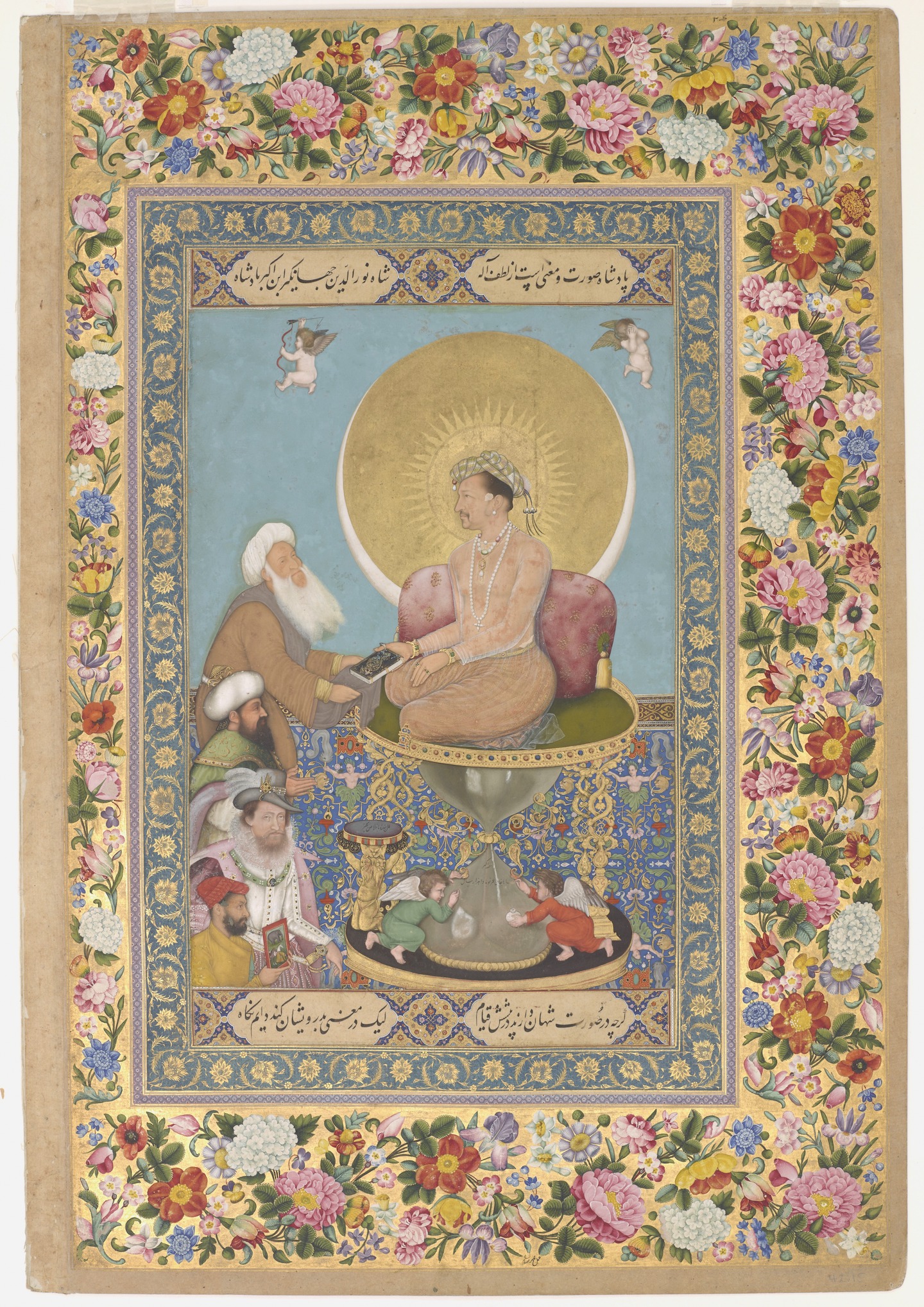
Jahangir Preferring a Su Shaikh to Kings. Bichitr. c. 1620 C.E. Watercolor, gold, and ink on paper.
Islamic/Hindu Manuscript
Hierarchy of scale → Salim is the largest of the 5 figures in the piece
Artist includes himself → to worship the emperor, he is humbly bowing to the emperor
Implies the extreme nature of emperor’s dominion (kings bowed down to him)
Once part of a ”muraqqa” - Bound book of powerful artworks
Themes: Supreme power/authority, royal lineage, wealth, transcendence (not toughing floor)
Connections: Wall Plaque from Oba’s Palace, Illuminated Manuscripts, Veranda Post, Court of Gayumars
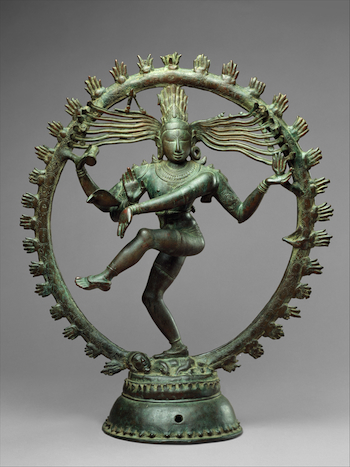
Shiva as Lord of Dance (Nataraja). Hindu; India (Tamil Nadu), Chola Dynasty. c. 11th century C.E. Cast bronze.
Hinduism
Intended to be movable during processional parade
Literal embodiment of the divine
Damaru (drum) in upper right hand symbolizes creation and time
Worshipped by Hindu devotees
Religious worship
Themes: Destruction and creation, devotion to worship, cultural heritage
Connections: Lakshmana Temple, Anthropomorphic Stele, Pallete of King Narmer, Seated Boxer/Wall Plaque
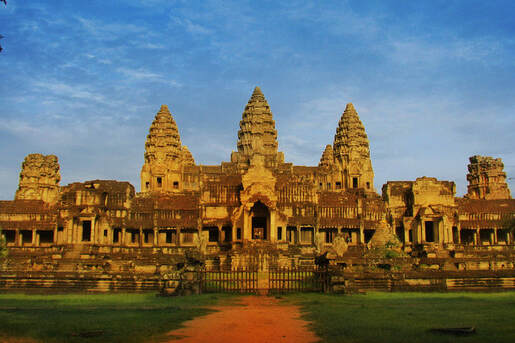
Angkor, the temple of Angkor Wat, and the city of Angkor Thom, Cambodia. Hindu, Angkor Dynasty. c. 800–1400 C.E. Stone masonry, sandstone.
Hinduism
Largest religious monument in the world
Mimcs 5 mountain ranges of Mt. Muru (mystical home of the gods)
Carved Bas reliefs of Hindu narratives
Dedicated to Hindu god Vishnu
Supreme abode for Vishnu
Intended to demonstrate the Angkor Kingdom’s and the King’s central place in the universe
Construction is a map of the cosmos (mandala)
Themes: Religion, cosmic symbolism, devotion to worship, Khmer architecture, cultural symbolism
Connections: Lakshmana Temple, Borobudur Temple, Great Serpent Mound (cosmic connection)

Lakshmana Temple. Khajuraho, India. Hindu, Chandella Dynasty. c. 930–950 C.E Sandstone.
Hinduism
Ganesha Niche: symbolizes the correct direction for circumambulation (walking around), associated with beginnings
Lively sculptures with dramatic “triple-bend” contrapasso poses carved in deep relief
Originally constructed as a place of worship for followers of Vishnu
Served as a hub for religious and cultural activities during the time of its construction
Nagara style → Hindu temple architecture
Themes: Religion, culture
Connections: Angkor Wat, Great Stupa at Sanchi, Longmen Caves, Borobudur Temple
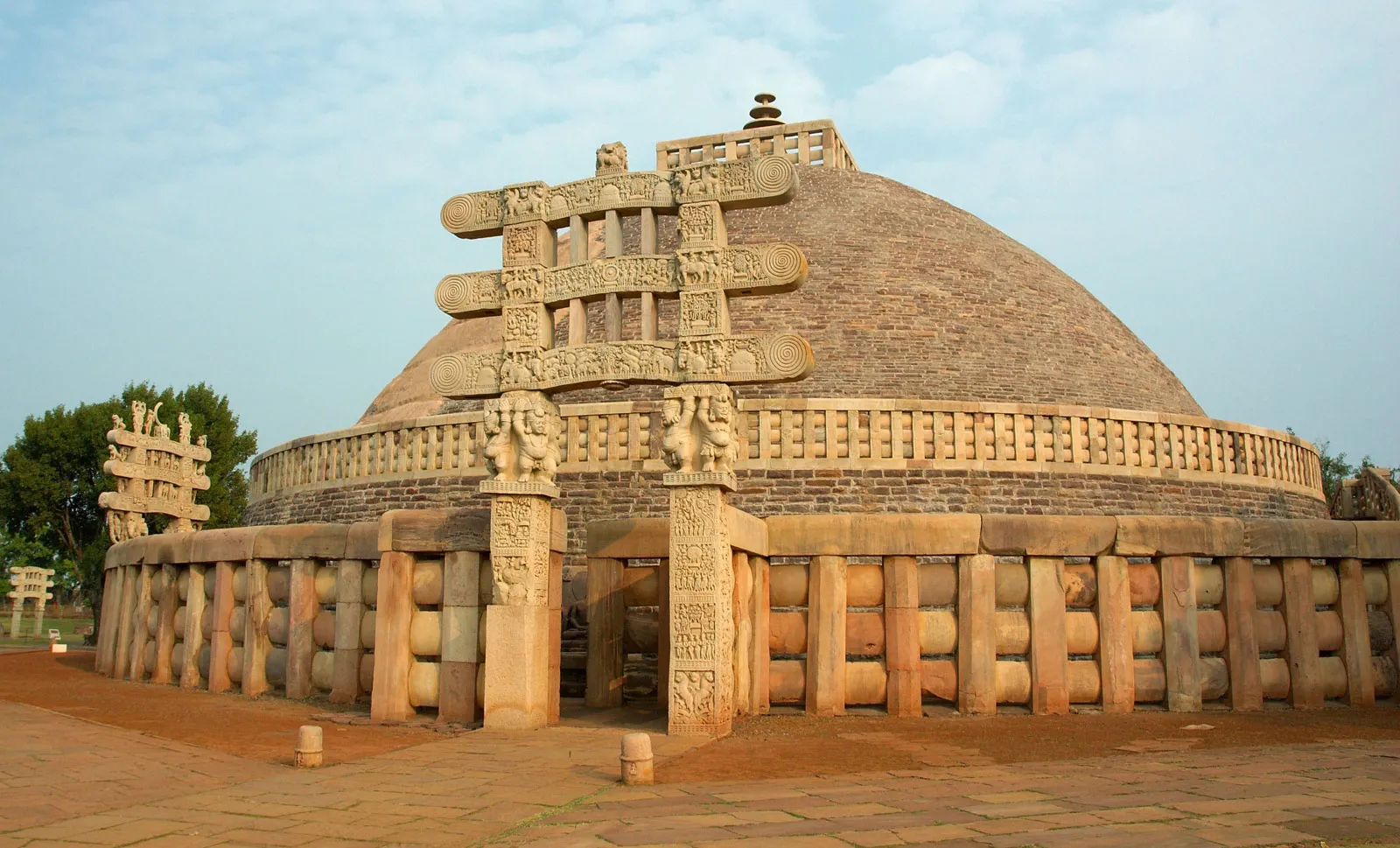
Great Stupa at Sanchi. Madhya Pradesh, India. Buddhist; Maurya, late Sunga Dynasty. c. 300 B.C.E.–100 C.E. Stone masonry, sandstone on dome.
Buddhism - India
Carvings show Ashoka grieving his wives
Commissioned by the Emperor Ashoka the Great
Great teachers used to be buried sitting up, with a mound of dirt covering them
Walk around it as a mediational practice
Themes: Culture, religion, afterlife, karma
Connections: Spiral Getty, Dome of the Rock, Kaaba, Lakshmana Temple
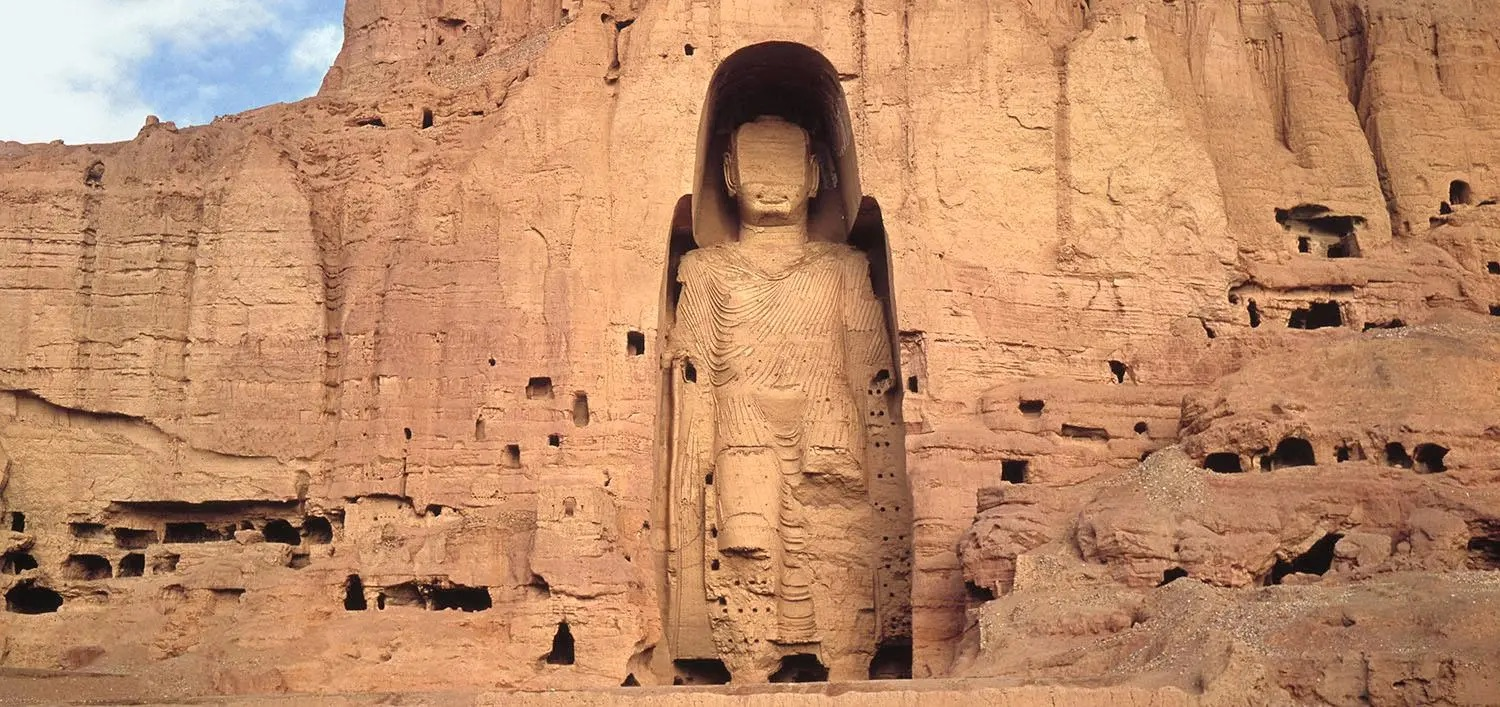
Buddha. Bamiyan, Afghanistan. Gandharan. c. 400–800 C.E. (destroyed in 2001). Cut rock with plaster and polychrome paint.
Buddhism - Afghanistan
Centerpiece of a flourishing Buddhist community
manifested the power and piety of the royal benefactors
Dramatic reminder to follow Buddhist practices
Represent Buddha as more than a teacher, but also as a guiding spirit
Flowing robes with wavy curls
Situated on Silk Road
Region served as both a commercial hub and spiritual center
Feet and legs carved into rock, allowing circumambulation
Hairstyle and drapery represent Hellenistic Greek traditions and Indian subject matter
Themes: Religion, trade, spirituality, culture, influence
Connections: Petra, Jowo Rinpoche, Pure Land, Mesa Verde, Kaaba (Walking around in a circle)

Longmen Caves. Luoyang, China. Tang Dynasty. 493–1127 C.E. Limestone.
Buddhism- China
Fengxian sculpture: high relief in a half-circle
Softer and rounder modeling and calm facial expressions
3 caves
Central cave: Buddha seared on a lion throne, mudra hand gesture
Rulers held the religion to affirm assimilation and superiority
Northern Wei rulers used Buddhist iconography to assert authority and dominance
Movement in the ruffles of robe
Blending Northern Wei style and Chinese style
Northern Wei Style: linear and abstract motifs
Chinese style: curvy and dynamic decorations
Themes: Power, superiority, Buddhism, religion
Connections: The Buddha, Bamiyan Buddhas
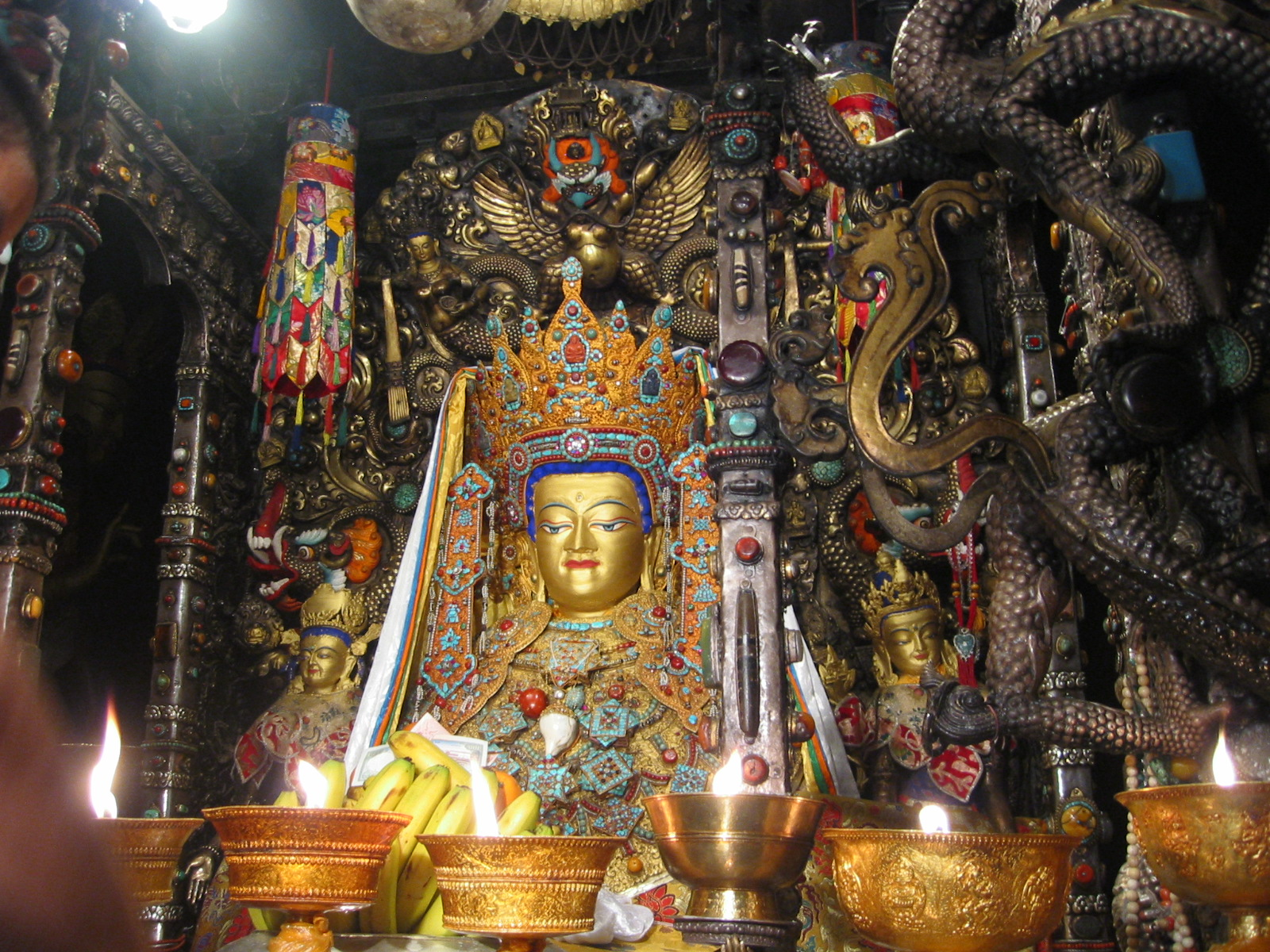
Jowo Rinpoche, enshrined in the Jokhang Temple. Lhasa, Tibet. Yarlung Dynasty. Believed to have been brought to Tibet in 641 C.E. Gilt metals with semiprecious stones, pearls, and paint; various offerings.
Buddhism - Tibet
In the “calling the Earth to witness” pose (mudra)
On a religious altar → people bring offerings to it
Regarded as the most accurate depiction of Buddha Shakuamurie and thought to have a direct lineage to the Buddha
To act as the Buddha’s proxy
Looking down → more present
Themes: Worship, religion, enlightenment
Connections: Emerald Buddha, Bamiyan Buddha, Tutankhamun’s Tomb, Golden Stool
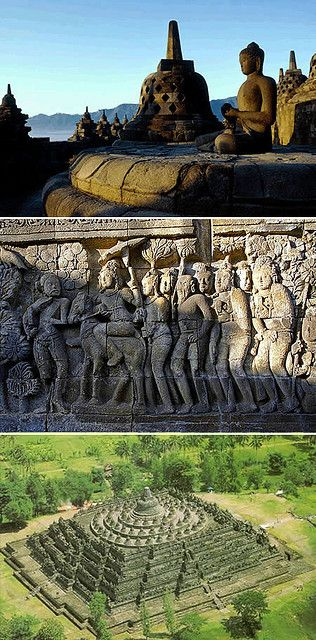
Borobudur Temple. Central Java, Indonesia. Sailendra Dynasty. c. 750–842 C.E. Volcanic-stone masonry.
Buddhism - Indonesia
Reliefs depict the Dharma (Buddha’s teachings)
Diagram of the cosmos
For religious rituals
Place of worship
Main message of the scriptures is enlightenment (complete elimination of suffering and dissatisfaction)
Themes: Worship, afterlife, power, astronomy, religion
Connections: Machu Picchu, any other relief carvings, Buddha, Longmen Caves
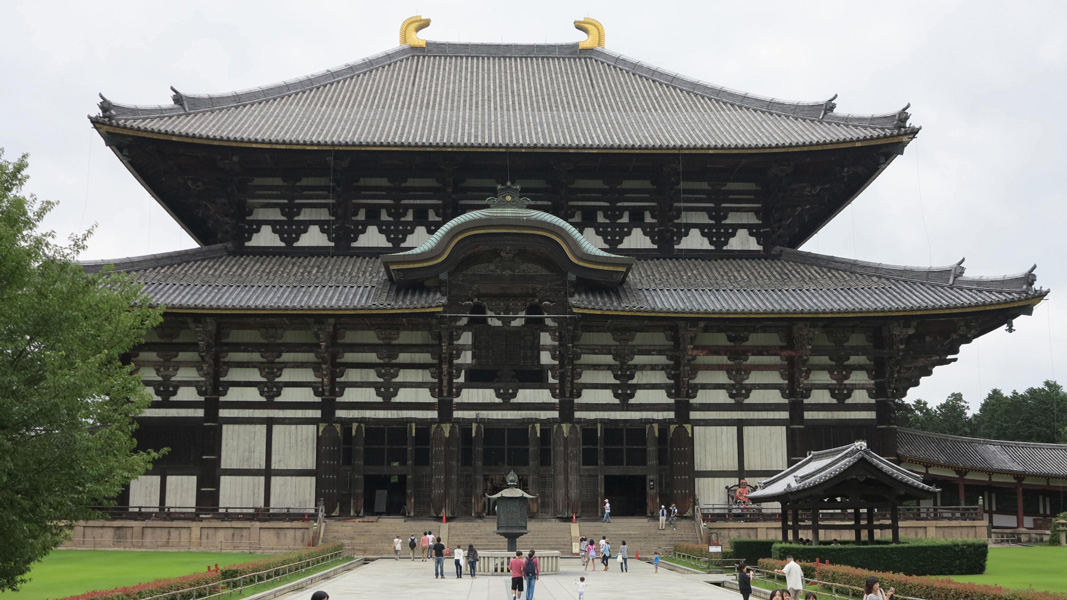
Todai-ji. Nara, Japan. Various artists, including sculptors Unkei and Keikei, as well as the Kei School. 743 C.E.; rebuilt c. 1700. Bronze and wood (sculpture); wood with ceramic-tile roo ng (architecture).
Buddhism - Japan
First completion joined Buddhism and politics
Rebuilding brought in an era of Shoguns
Housed Japan’s best school of sculpture
Huge bronze Buddha inside temple
Designed to be the chief temple in the Kokuban-ji system and the place of national ritual
To promote Buddhism as protector of the state
Large scale (very big)
Themes: Religion/spirituality, unity, politics
Connections: Jowo Rinpoche
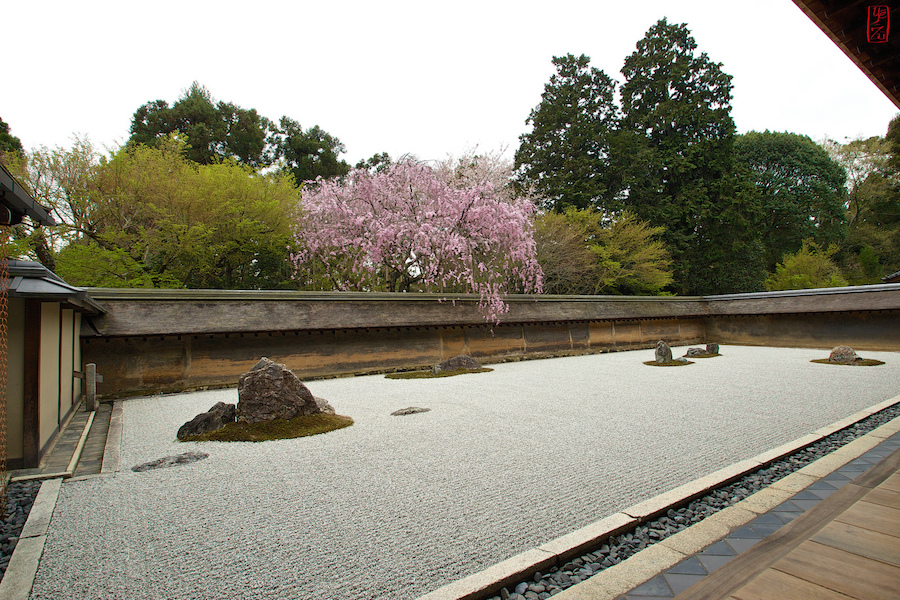
Ryoan-ji. Kyoto, Japan. Muromachi Period, Japan. c. 1480 C.E.; current design most likely dates to the 18th century. Rock garden.
Buddhism - Japan
Arranged in such a way that you can only see 14 rocks at a time
Looks like water, but actually small rocks
You’re never complete, there’s always room to grow
Temple also has mirror pond, stone/moss garden
Rocks have unclear meaning: higher carrying cubs, sen philosophy, or islands in the ocean
From Edo period
Religious site for Zen Buddhism
Used for meditation and finding peace
Themes: Religion, meditation/relaxation, culture, nature
Connections: Dome of the Rock, Great Stupa at Sanchi, Temple of Amun-Re, Spiral Jetty
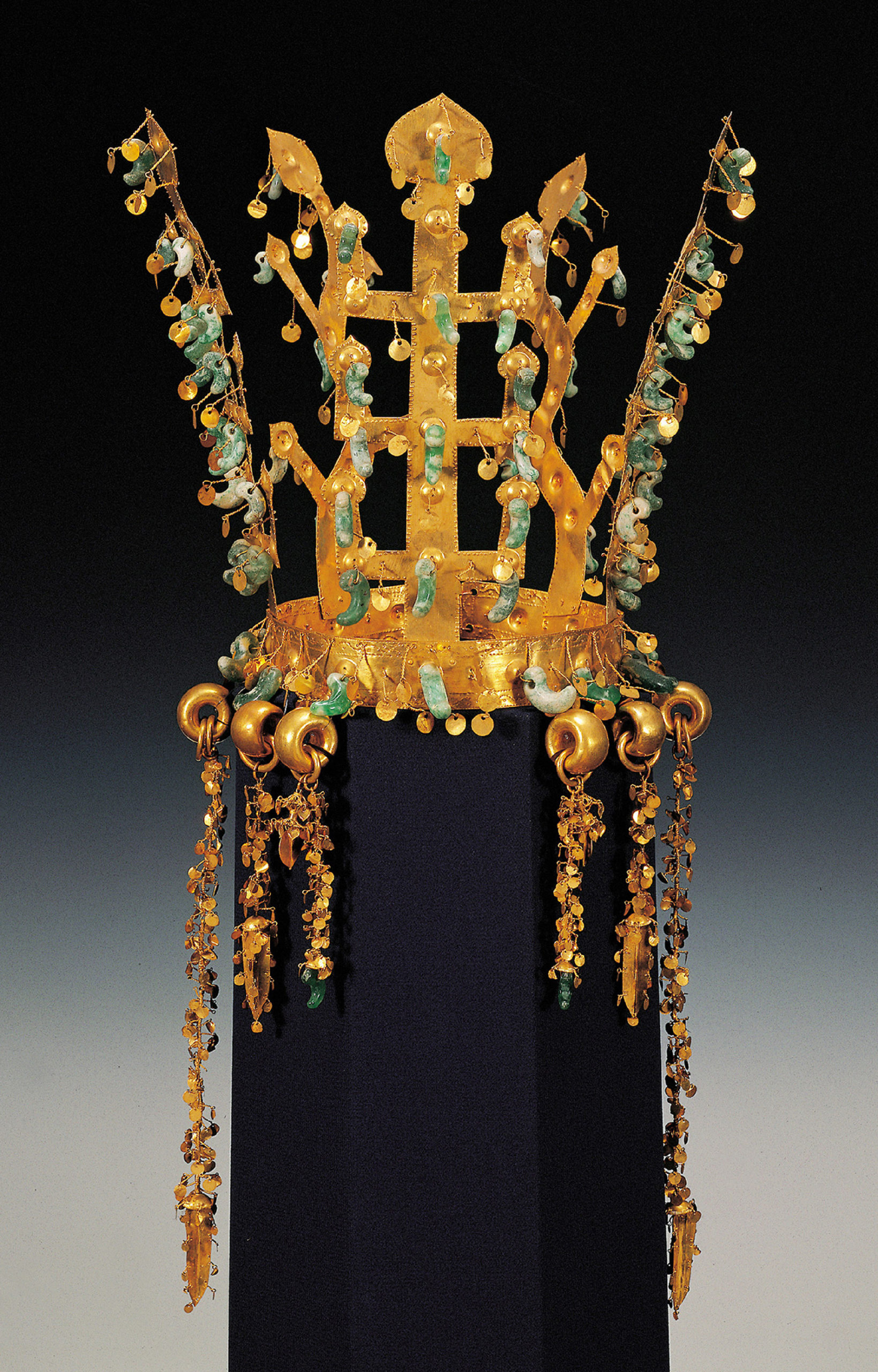
Gold and Jade crown. Three Kingdoms Period, Silla Kingdom, Korea. Fifth to sixth century C.E. Metalwork.
Korea
Emphasized the power of the wearer through the precious materials and natural imagery
Represents fertility and abundance
Burial rituals; convert social status of tomb occupant in afterlife
Made to look like a tree
From Silla Kingdom
Themes: Fertility, afterlife, ceremony, nature
Connections: Ruler’s Feather Headdress
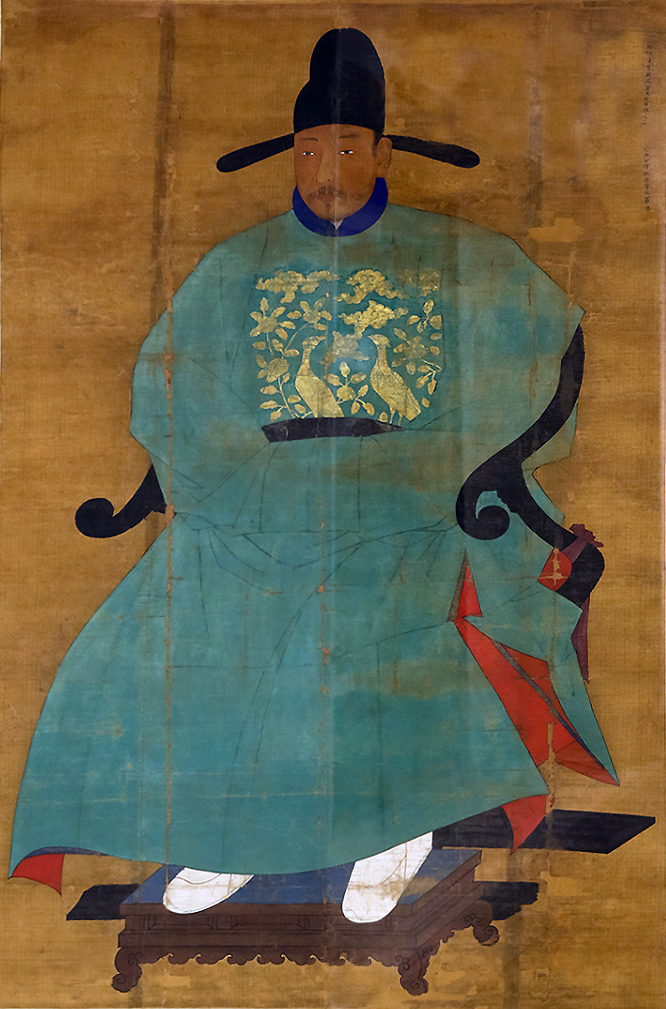
Portrait of Sin Sukju (1417–1475). Imperial Bureau of Painting. c. 15th century C.E. Hanging scroll (ink and color on silk).
Korea
Sin Sukju in his official robes with a black silk hat on his head
Rank badge on his chest
Sin Sukju - eminent scholar and politician who rose to the rank of prime minister
Cherished by families and worshipped for generations to follow
To honor the accomplishments of the distinguished court member and prime minister
Suggests his loyalty to the king and that he deserves respect for staying loyal
Seated in full-length view
Themes: Honor, rule, loyalty, rank, propaganda, ancestral worship, importance of family
Connections: Tamati Waka Nene, Augustus of Primaporta, Chairman Mao
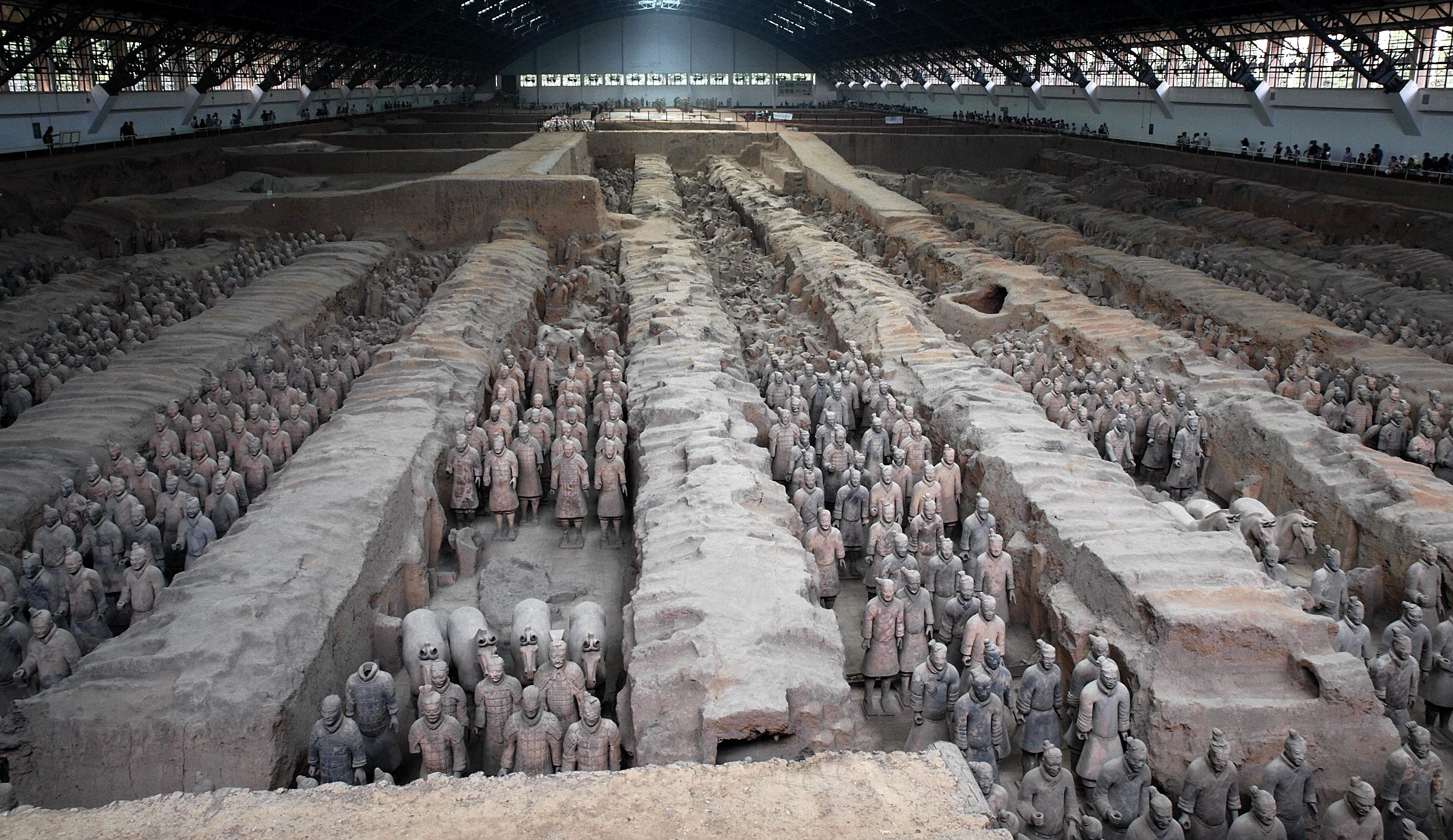
Terra Cotta Warriors Qin Dynasty. c. 221–209 B.C.E. Painted terra cotta.
China
Super original in concept and execution
Underground city guarded by a life-sized terra cotta army
Full army → horses, chariots, army
The first emperor Qin Shi Huang sought to conquer death
Tomb of the Emperor Qin Shi Huang designed to protect him in the afterlife
Each terra cotta figure has distinct features
Figures were made using an assembly lines style of production
Themes: Burial, death, afterlife, legacy
Connections: Last Judgement of Hunefer, Tutankhamun’s Tomb, Jade Cong
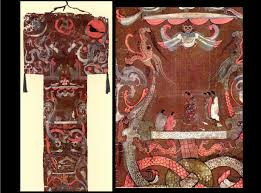
Funeral banner of Lady Dai (Xin Zhui). Han Dynasty, China. c. 180 B.C.E. Painted silk.
China
Top to bottom: Heavenly realm → Lady Dai and her attendants → Body of Lade Dai with mourners → Underworld
Sun and moon symbolize supernatural world
Elaborate
Earliest known portrait in Chinese Painting
Connection with the afterlife
Used to identify the dead during the mourning ceremonies
Shrouds used during burial, intended to facilitate the soul’s journey to the afterlife
Themes: Culture, religion, afterlife
Connections: Last Judgement of Hunefer, Portrait of Sin Sukju, Terracotta Warriors, Tamati Waka Nene

Travelers among Mountains and Streams. Fan Kuan. c. 1000 C.E. Ink and colors on silk.
China - Daoism
More focus on landscape than people
To portray vast landscape
To show detail and design
To show neo-confucian theory
Incisive thickening-and-thinning contour strokes
Themes: Nature, culture, landscape, scale
Connections: The Oxbow, White and Red Plum Blossoms

Forbidden City. Beijing, China. Ming Dynasty. 15th century C.E. and later. Stone masonry, marble, brick, wood, and ceramic tile.
China
9000 temples, residences, halls, rooms
Palace of Heavenly Purity → emperor’s residence/ceremonial hall
Hall of Mental Cultivation → emperor’s residence
Palace of Earthly Tranquility → empresses’ residence
Ming and Qing Dynasties
Throne placed at center Each corner represents corners of the world
Animal gargoyles ward against evil
Emperors/families/officials only
Political center
Themes: Power, politics, architecture, tradition, religion
Connections: Templo Mayor, Palace of Versailles, Angkor Wat, Athenian Agora
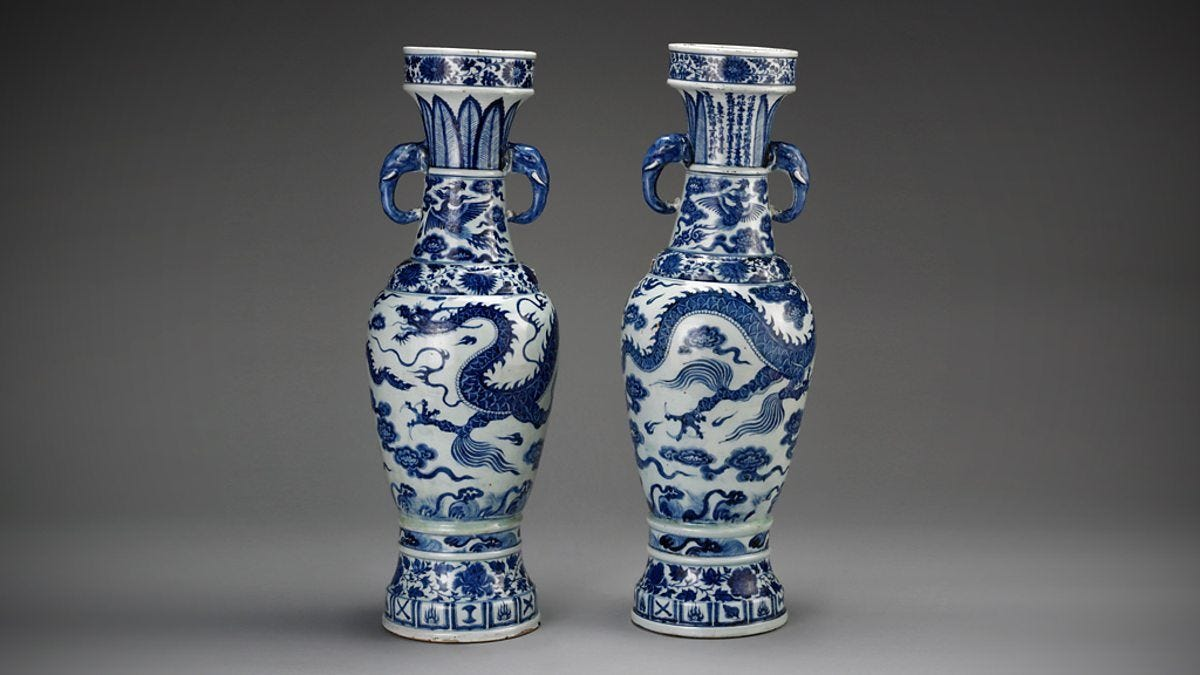
The David Vases. Yuan Dynasty, China. 1351 C.E. White porcelain with cobalt-blue underglaze.
Daoism - China
Silk Road
Yuan Dynasty
Among the most important examples of blue and white porcelain
Made for the alter of a Daoist temple
Created as an offering to higher deities
Themes: Spirituality, culture, history
Connections: Niobides Krater
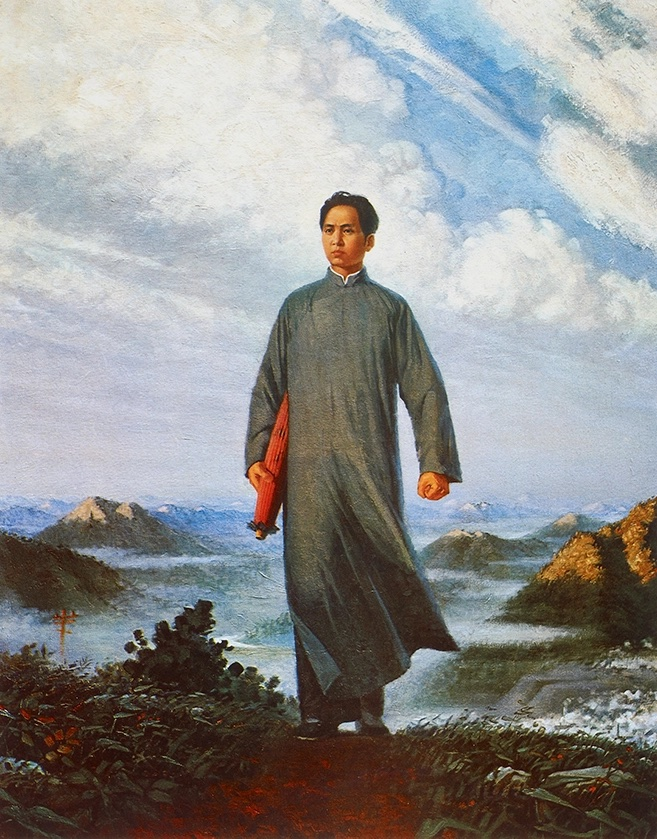
Chairman Mao en Route to Anyuan. Artist unknown; based on an oil painting by Liu Chunhua. c. 1969 C.E. Color lithograph.
Modern China
Printmaking → mass production
Piece of propaganda art
Mao Zedong: A revolutionary of China’s communist party
Portrays Mao on his way to the Anyuan coal-mining strike
Part of a series “Mao Paintings” in an effort to regain factor in his politics
Trying to move into a more modern style to match the economy and country, but still able to see remnants of traditional values
Archaic smile
Themes: Politics, propaganda
Connections: Augustus of Primaporta, The Results of the Five Year Plan

Night Attack on the Sanjô Palace. Kamakura Period, Japan. c. 1250–1300 C.E. Handscroll (ink and color on paper).
Japan
Stories told from Victor’s POV
Appears on a handscroll
Individualized gestures and facial expressions (horror to morbid humor)
Part of Fujiwara no Nobuyori's bid to seize power
Portrayal of the civil war between two clans (Taira and Minamoto)
Rhythm in the way the warriors, horses, and emperor are fleeing towards the left
Themes: War, hierarchy, victory, sacrifice, bloodshed/thirst
Connections: White and Red Plum Blossoms, Guernica, Column of Tajan, Bayeux Tapestry
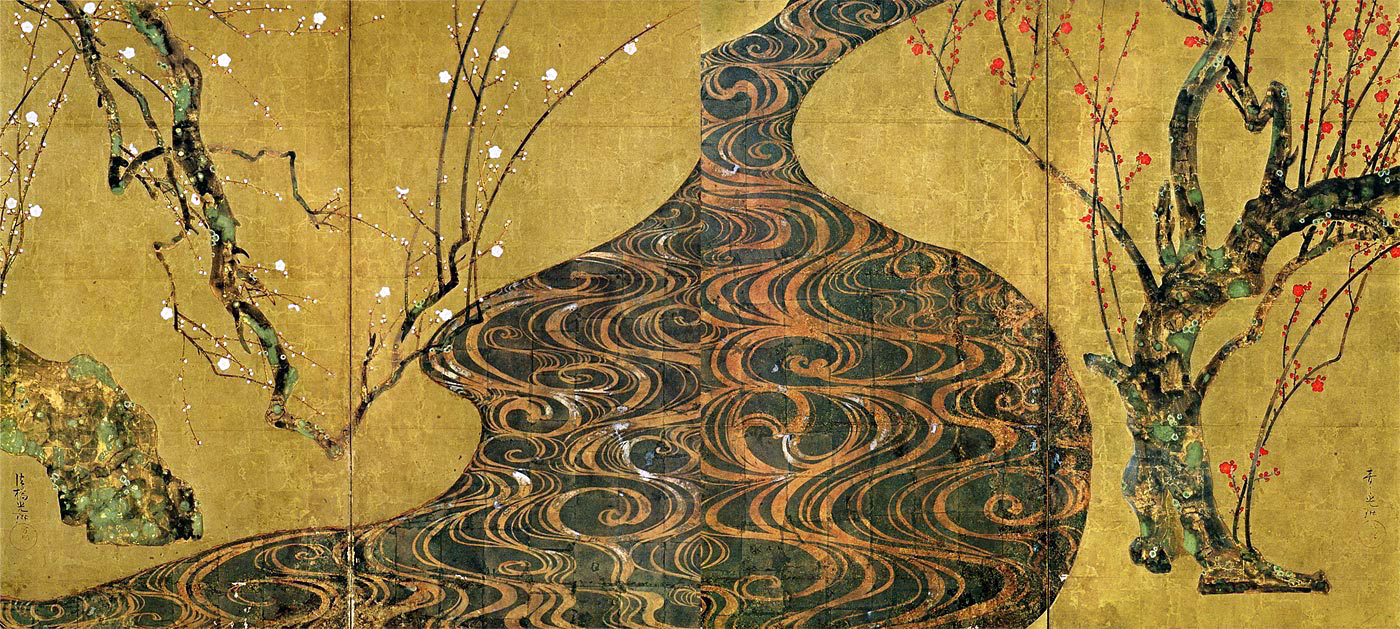
White and Red Plum Blossoms. Ogata Korin. c. 1710–1716 C.E. Ink, watercolor, and gold leaf on paper.
Japan
Created on a pair of folding screens
Both abstract and realistic
Style of art is commonly referred to as Rinpa (“School of Korin”)
Meant to replicate a traditional Japanese interior
Inspired other artists’ work such as The Kiss by Gustav Klimt
Gives the viewer the experience of viewing the 2D image in 3D because of the folding screens
Themes: Landscapes, tradition, nature, beauty, technique
Connections: Night Attack on the Sanjo Palace, Under to Wave off Kanagawa, Summer Trees, The Kiss (Gustav Klimt)

Under the Wave off Kanagawa (Kanagawa oki nami ura), also known as the Great Wave, from the series Thirty-six Views of Mount Fuji. Katsushika Hokusai. 1830– 1833 C.E. Polychrome woodblock print; ink and color on paper.
Japan - Edo Period
From a series
Nature is large and we are small
Printmaking: Can be easily reproduced
Arranged the composition to frame Mt. Fuji
Mountain made tiny by the use of perspective, appears as if the mountain too will be swallowed by the wave
Ukiyo-e print
Themes: Cultural identity
Connections: Ryoan-Ji, Slave Ship, Winged Victory, Travelers Among Mountains and Streams
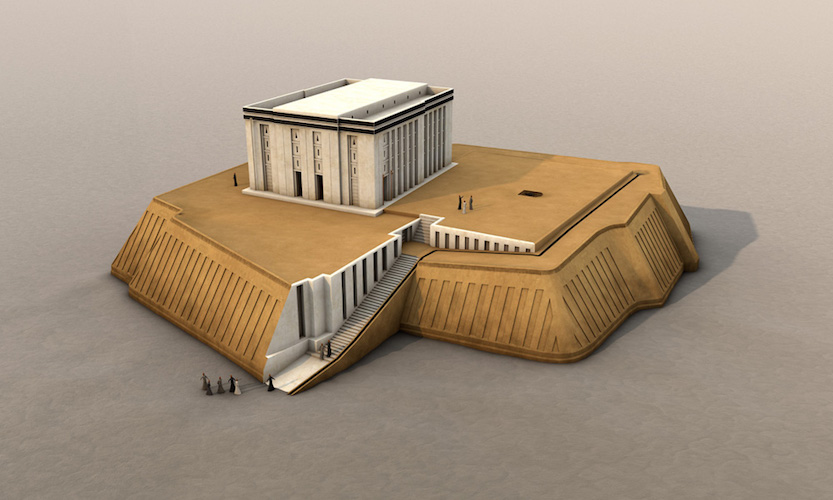
White Temple and Ziggurat. Uruk (modern Iraq). Sumerian. c. 3500–3000 B.C.E. Mud brick.
Sumerian
Earliest form of architecture that influenced other works
Represented the Sky god Anu’s religious and political authority
Ziggurat: a raised platform with four sloping sides
Function: Animal sacrifice
Themes: sacrifice
Connections: Pantheon
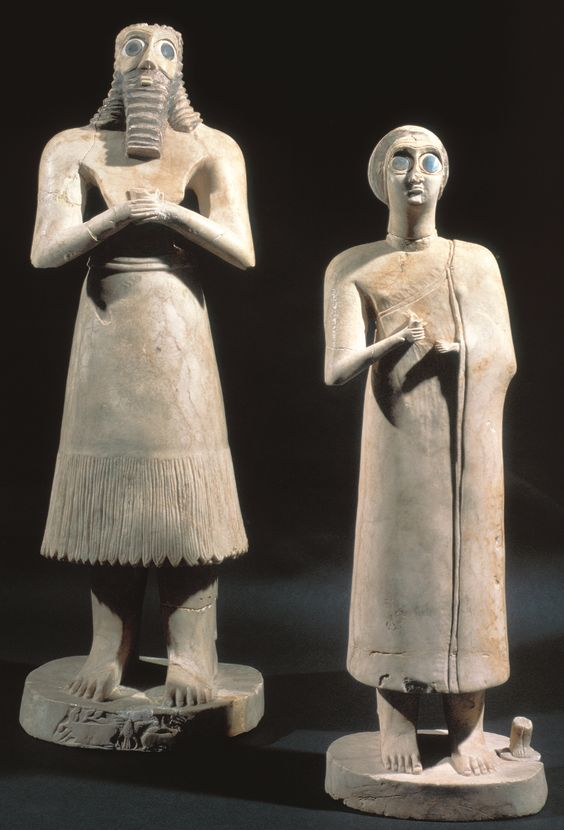
Statues of Votive Figures (modern Tell Asmar, Iraq). Sumerian.c. 2700 B.C.E. Gypsum inlaid with shell and black limestone.
Sumerian
Votive: Objects offered to a god or goddess at a sacred place
Pedestals (standing up during worship)
Huge eyes, hands clasped in prayer
Supposed to feel static like it’s forever rating to the god
Portable
Stand-in object for a wealthy person; your presence is in this object; to offer continuous prayer
Realistic anatomy
Themes: Religion
Connections: Ambum stone, Venus of Vilandorf, Female Deity, Ikenga
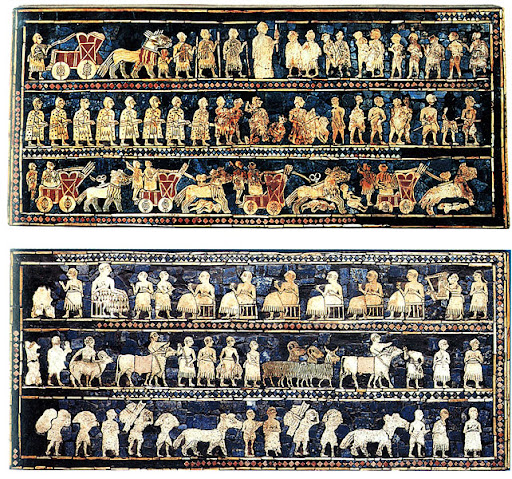
Standard of Ur Sumerian. c. 2600–2400 B.C.E. Wood inlaid with shell, lapis lazuli, and red limestone.
Sumerian
Contrast in society: peace v war
Mosiac
Social hierarchy → wealthy on top
Profile view
War side: More intense colors, chariots trampling enemies, soldiers carrying spears
Peace side: Naturalistic colors, more peaceful, banquet setting
Trying to show an emerging society
People of different skills being depicted
Themes: War, peace
Connections: Alexander Mosiac
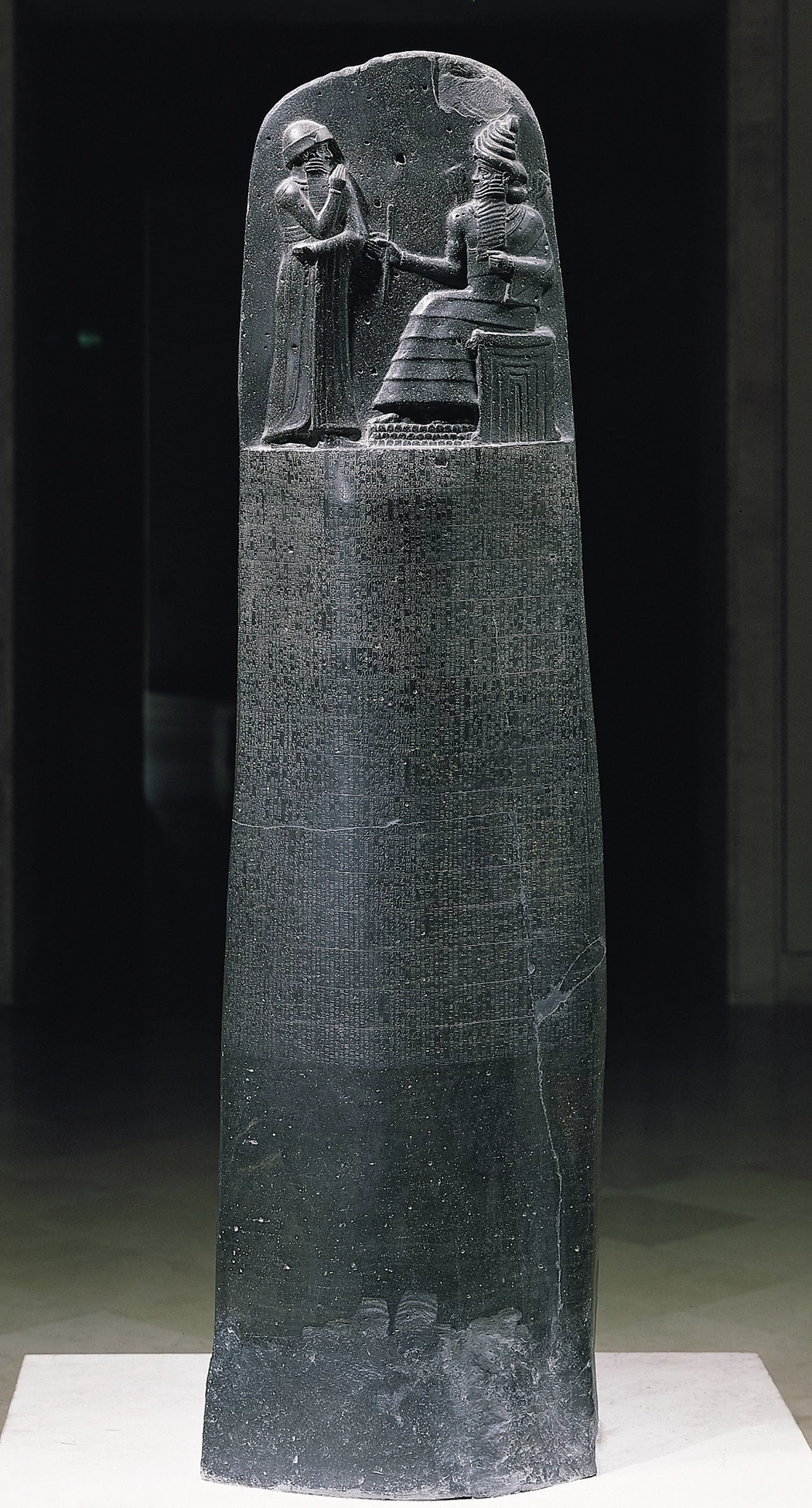
The Code of Hammurabi. Babylon (modern Iran). Susian. c. 1792–1750 B.C.E. Basalt.
Babylonian
Large stele
2 figures: King Hammurabi and Shamash (god of sun and justice)
First set of written laws, predates biblical text
To create a set of very specific written laws
Shamash in composite view (shoulders are frontal, head in profile)
Hierarchy of scale: Hammurabi and Shamash are same size
Themes: Rule of law, justice, authority, iconography
Connections: Parthenon, Pallete of King Narmer
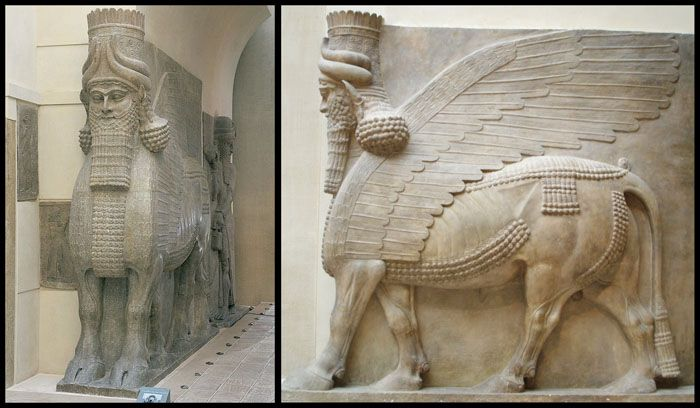
Lamassu from the citadel of Sargon II, Dur Sharrukin (modern Khorsabad, Iraq). Neo-Assyrian. c. 720–705 B.C.E. Alabaster.
Akkadian
Curiform: early form of writing
5 legs in an attempt to show movement
Human head: intelligence, Bull’s body: strength, wings: freedom, crown and beard: wise
Lamassu guarded gates of the Assyrian citadel of Sargon II
Protective guardians against outside supernatural powers
served to protect the gods as well as the important human
Themes: Guardianship, God, safety, security
Connections: Winged Victory, Augustus of Primaporta, Code of Hammurabi, The Great Sphinx, Ambum Stone

Audience Hall of Darius and Xerxes. Persepolis, Iran. Persian. c. 520–465 B.C.E. Limestone.
Persian
Depicts the annual tribute processsions where representatives from the empire’s provinces brought gifts, goods, and tokens of allegiance to the Persian kings
Grand ceremonial hall within the larger complex of Persepolis
Ceremonial center
Served as the hub for political discussions
Elaborate relief scultpres
Cyclopean Masonary (stonework)
Themes: cultural, ceremonial, royalty, power, authority
Connections: White Temple and its Ziggurat, Temple of Amun-Re and Hypostyle Hall, Mortuary Temple of Hatshepsut
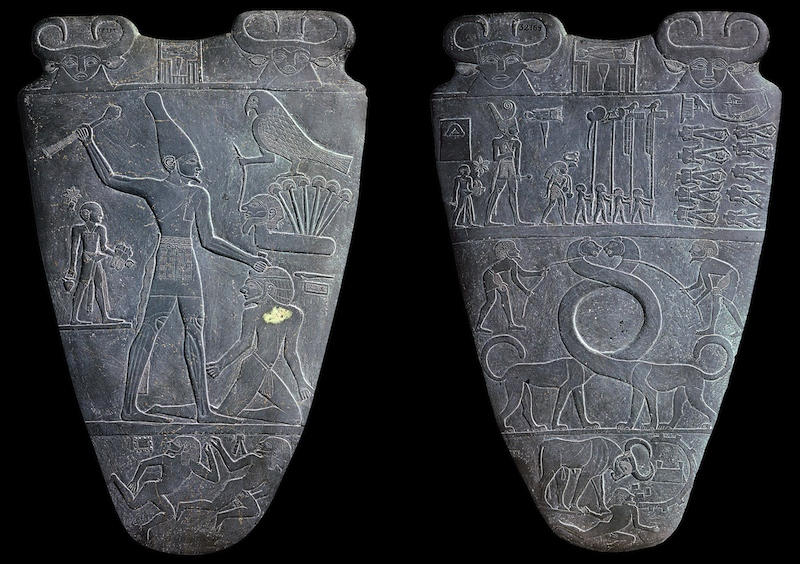
Palette of King Narmer. Predynastic Egypt. c. 3000–2920 B.C.E. Greywacke.
Predynastic Egypt
Profile view, elongated figures → very popular in Ancient Egyptian art
Hierarchy of scale
Relief sculpture
Unifying lower and upper Egypt
Palettes in Ancient Egypt were typically used to grind or mix cosmetics
Makeup palette

Great Pyramids (Menkaura, Khafre, Khufu) and Great Sphinx. Giza, Egypt. Old Kingdom, Fourth Dynasty. c. 2550–2490 B.C.E. Cut limestone.
Old Kingdom Egypt
“Staircase” build
Shape mimics the rays of the sun (pharaoh uses to climb up to the sky)
The 3 pyramids are named after the 3 kings (smallest - Menkaure, middle - Khafre, biggest - Khufu)
Primarily built for monumental tombs for pharaohs, showcasing their divine authority and belief in afterlife
Sphinx built as a protector of the pyramids and as a symbol of royal authority
Pyramids also hold valuables and act as a gateway to the afterlife
Themes: divine power of the pharaohs, afterlife, divine kingship, cultural, legacy, power
Connections: King Menaure and Queen, Large Kneeling Statue of Hatshepsut, Temple of Amun-Re
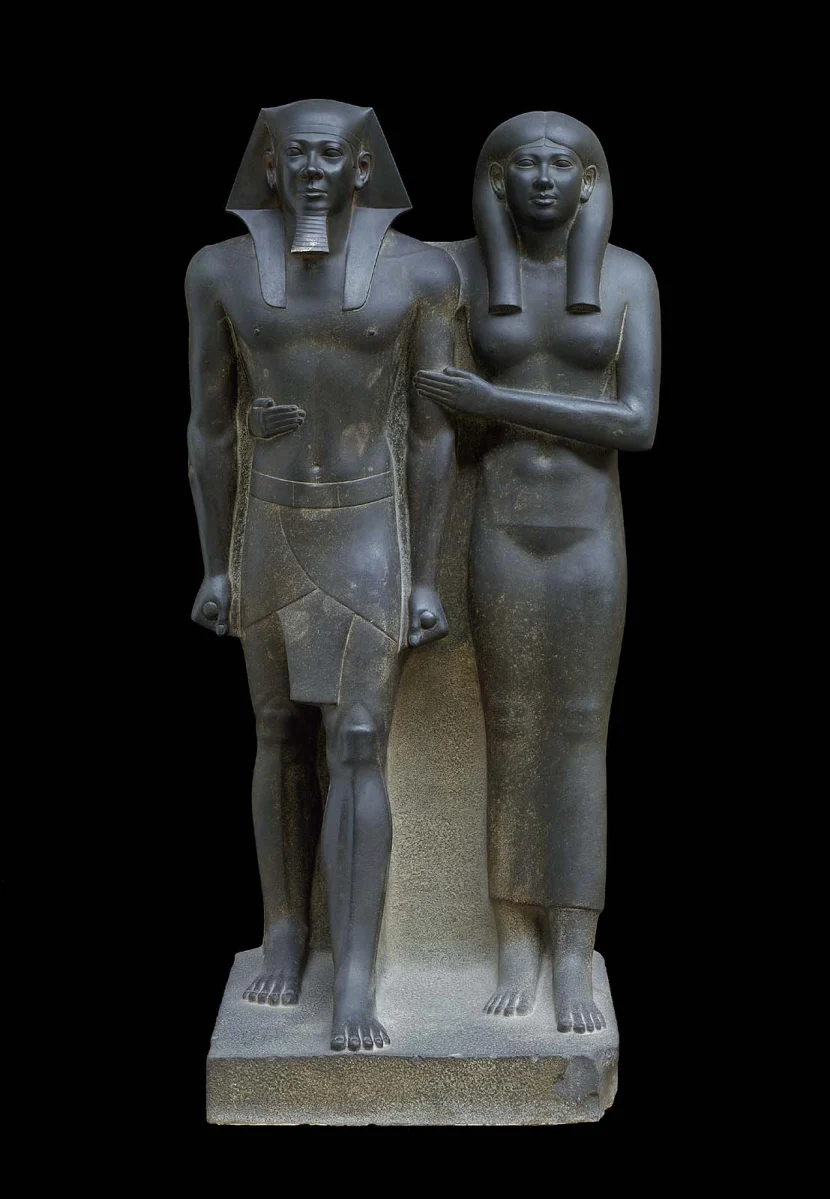
King Menkaura and Queen. Old Kingdom, Fourth Dynasty. c. 2490–2472 B.C.E. Greywacke
Old Kingdom Egypt
Contrapasso (stepping forward)
Archaic smile (looking towards the future)
King: young, strong man
Queen: perfect female body, importance of strong leadership
Stepping with left foot; no human emotions = meant to look more god-like/example of the divine king and queen
To honor and remember King Mekuara and the Queen during their afterlife
Showed how kings were considered divine
Themes: Roylaty, eternity, partnership, religious beliefs
Connections: Great Pyramids, Augustus of Primaporta, Peplos Kore, Venus
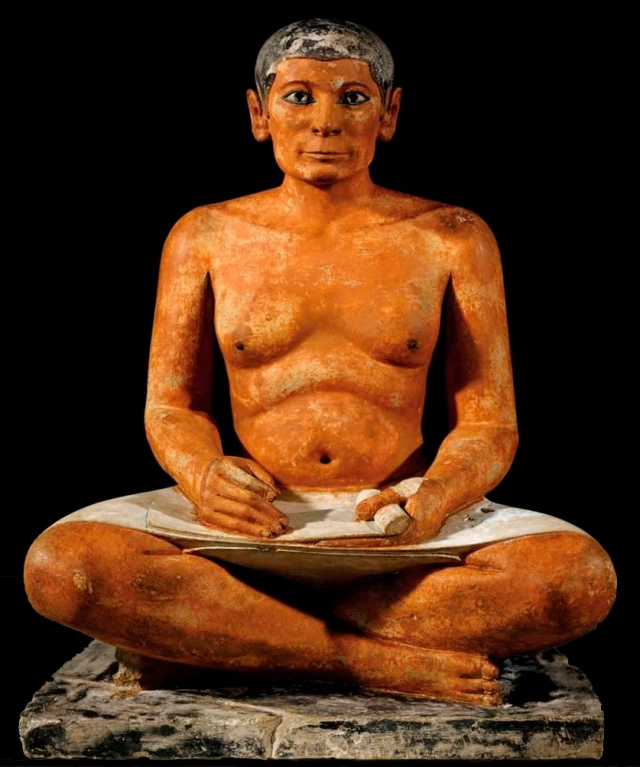
Seated Scribe. Egypt. Old Kingdom, Fourth Dynasty. c. 2620–2500 B.C.E. Painted limestone.
Old Kingdom Egypt
Sitting symbolizes humbling status, position of power
Unusual in Egyptian art because not focused on a ruler
Focus on naturalism and realism
Massive jump in realism
Themes: naturalism
Connections: Seated Boxer

Temple of Amun-Re and Hypostyle Hall. Karnak, near Luxor, Egypt. New Kingdom, 18th and 19th Dynasties. Temple: c. 1550 B.C.E.; hall: c. 1250 B.C.E. Cut sandstone and mud brick.
New Kingdom Egypt
Hypostyle hall inspired by reeds of the Nile
Celestory lighting
Reliefs honor Pharoah’s devotion to Amun-Re
Dedicated to sun god Amun-Re
Place of worship and devotion to Amun-Re
Site for pilgrimages
Represents divine kingship
Themes: religious devotion, expression, spirituality, offering, identity
Connections: Great Sphinx and Pyramids, Mortuary Temple of Hatshepsut
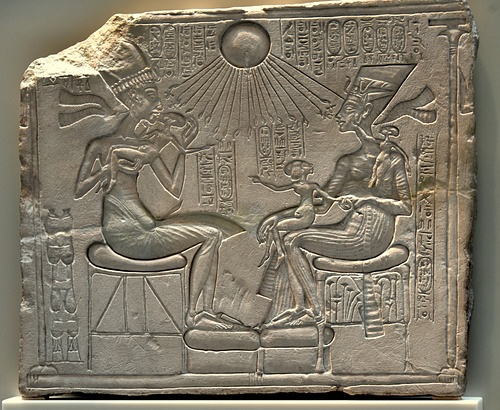
Akhenaton, Nefertiti, and Three Daughters. New Kingdom (Amarna), 18th Dynasty. c. 1353–1335 B.C.E. Limestone.
New Kingdom (Armana)
Armana: period where they went a little wild with their artwork (goes outside canon)
Canon: when you see something over and over again in artwork
To introduce the idea of family to the Egyptian people
Showing the elements of being equal
Shoe the worshipping of Amin/Aten
Body proportions are long, with wide hips, thin legs, and curved necks
Themes: Family, change, equality, religion
Connections: Grave Stele of Hegosa, Woman I, Surrealist artworks (departure from art genres)

Tutankhamun’s Tomb New Kingdom, 18th Dynasty. c. 1323 B.C.E. Gold with inlay of enamel and semi precious stones.
New Kingdom Egypt
Sarcophagus
Crook and flail associated with Osirus, god of death → symbolized power and order
Cobra represents Lower Egypt, vulture represents Upper Egypt
Hieroglyphic and symbolic carvings talking about his life
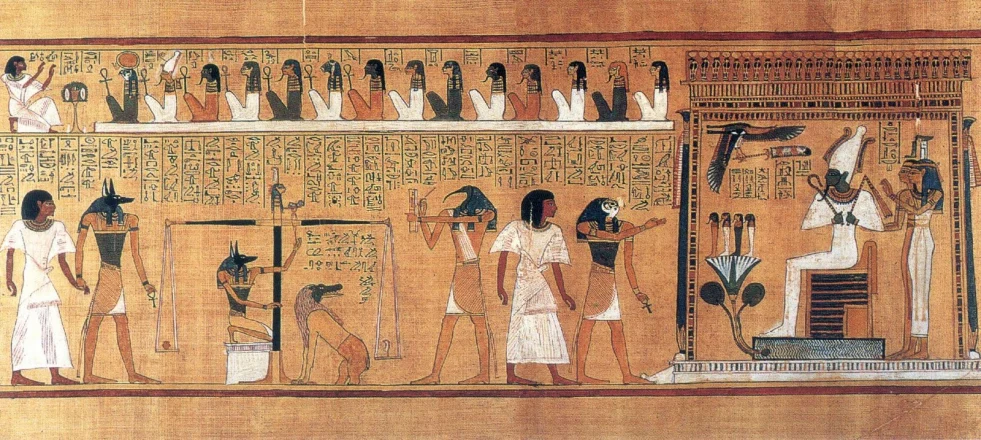
Last Judgment of Hu-Nefer, (page from the Book of the Dead). New Kingdom, 19th Dynasty. c. 1275 B.C.E. Painted papyrus scroll.
New Kingdom Egypt
Buried in the tomb of Hu-Nefer
A scribe had a priestly status in Ancient Egyptian culture
Book of the Dead is ancient text with spells and prayers that the dead would need to get into the afterlife
Made for a scribe
Placed in tombs and believed to protect and aid the deceased in the hereafter
Twisted perspective: figures in part profile, part frontal
Balance and order in the repetition of motifs
Continuous narrative
Hierarchy of scale
Themes: Afterlife, death, rebirth, funerary
Connections: Standard of Ur, Seated Scribe

Athenian Agora. Archaic through Hellenistic Greek. 600 B.C.E.–150 C.E. Plan.
Archaic → Hellenistic Greek
Agora: place of gathering
Known as the birthplace of democracy
Greeks inspired the Romans → connection to Roman forum
Open-air stadium that served as a marketplace and civil center for Ancient Greece
Meritocracy: the belief that those in power show earn their position mainly based on merit
Patriarchical: only men allowed to participate in conversation regarding politics or business
Marketplace and civil center
For business, politics, trade, festivals, sports, community
Collandes (rows of long columns)
Themes: Democracy, community/society, religion/holiness
Connections: Acropolis, Roman Forum

Anavysos Kouros. Archaic Greek. c. 530 B.C.E. Marble with remnants of paint.
Archaic Greek
Kouros: “Youth”
Ideal male form
Soldier/kouros: someone who died in war and his aristocratic family wanted a grave marker to honor him
“Perfect young male”
Represents youthful potential lost and the spiritual ascension
Archaic period → figures became more natural and lifelike
Grave marking
Honoring Kroisos
Traces of the original paint on the hair, nose, and eyes
Realistic movements and anatomy
Technically beginning of Contrapassto
Archaic smile
Themes: beauty standards, ideal male, human form, death
Connections: King Menkuare and Queen, Peplos Kore, Doryphoros
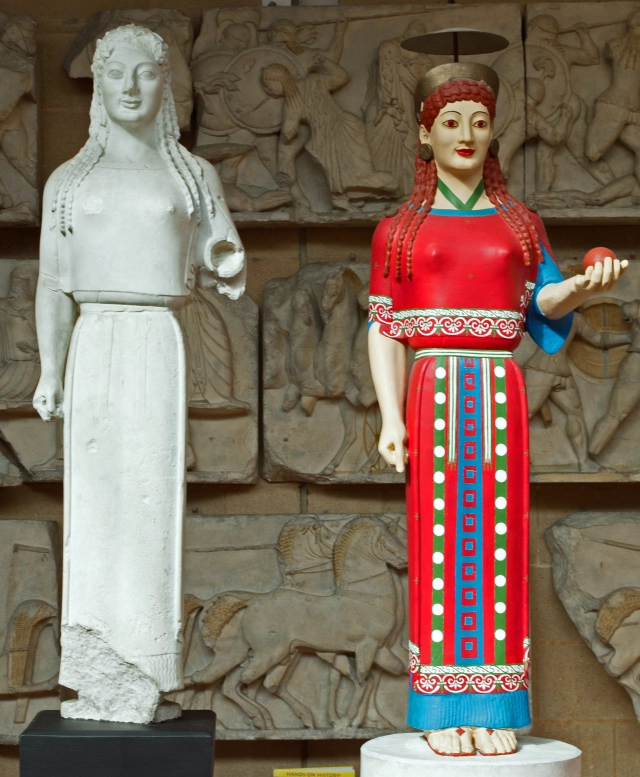
Peplos Kore from the Acropolis. Archaic Greek. c. 530 B.C.E. Marble, painted details.
Archaic Greek
Clothed
Peplos: garment worn by Greek women during early Archaic period
Kore: female figure, always clothed
Grave marker
Offering to the goddess Athena
Archaic smile
Only front of body displays fine detail